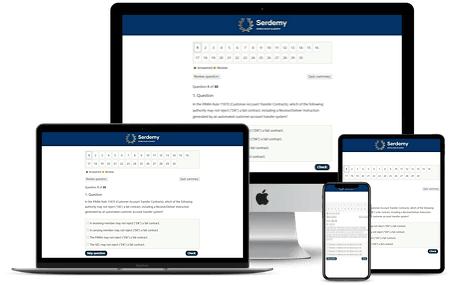Quiz-summary
0 of 30 questions completed
Questions:
- 1
- 2
- 3
- 4
- 5
- 6
- 7
- 8
- 9
- 10
- 11
- 12
- 13
- 14
- 15
- 16
- 17
- 18
- 19
- 20
- 21
- 22
- 23
- 24
- 25
- 26
- 27
- 28
- 29
- 30
Information
Premium Practice Questions
You have already completed the quiz before. Hence you can not start it again.
Quiz is loading...
You must sign in or sign up to start the quiz.
You have to finish following quiz, to start this quiz:
Results
0 of 30 questions answered correctly
Your time:
Time has elapsed
Categories
- Not categorized 0%
- 1
- 2
- 3
- 4
- 5
- 6
- 7
- 8
- 9
- 10
- 11
- 12
- 13
- 14
- 15
- 16
- 17
- 18
- 19
- 20
- 21
- 22
- 23
- 24
- 25
- 26
- 27
- 28
- 29
- 30
- Answered
- Review
-
Question 1 of 30
1. Question
A managing broker-dealer for a Direct Participation Program, “Keystone Energy Partners LP,” is conducting a registered public offering on a “best efforts, all-or-none” basis. The goal is to raise $20 million to acquire and develop specific energy assets. By the offering’s termination date, only $18 million in subscriptions has been collected and placed in a proper escrow account. The program sponsor has already incurred $500,000 in bona fide, itemized organizational expenses for legal and accounting services related to structuring the partnership. In accordance with SEC Rules 10b-9 and 15c2-4, what is the required course of action?
Correct
The offering is structured as a “best efforts, all-or-none” contingency. According to SEC Rule 10b-9, this means the offering is void unless all the securities are sold by the specified deadline. Since the offering only raised $18 million out of the required $20 million, the contingency has failed. SEC Rule 15c2-4 governs the handling of customer funds in contingent offerings. This rule requires the broker-dealer to promptly transmit all payments received from investors into a separate escrow account with a qualified, independent bank. These funds must remain in escrow and cannot be accessed by the issuer or sponsor for any purpose until the contingency is successfully met. Because the “all-or-none” condition was not satisfied, the broker-dealer is obligated to promptly return 100% of the funds to the subscribers. No deductions of any kind are permitted from the escrowed funds. The $500,000 in bona fide organizational and offering expenses, while legitimate, are the responsibility of the program sponsor. These costs can only be paid from offering proceeds if the offering is successfully completed. Since it failed, the sponsor must cover these costs from their own capital, and investors must be made whole without any deductions. Any other action would violate both the terms of the offering under Rule 10b-9 and the fund handling requirements of Rule 15c2-4.
Incorrect
The offering is structured as a “best efforts, all-or-none” contingency. According to SEC Rule 10b-9, this means the offering is void unless all the securities are sold by the specified deadline. Since the offering only raised $18 million out of the required $20 million, the contingency has failed. SEC Rule 15c2-4 governs the handling of customer funds in contingent offerings. This rule requires the broker-dealer to promptly transmit all payments received from investors into a separate escrow account with a qualified, independent bank. These funds must remain in escrow and cannot be accessed by the issuer or sponsor for any purpose until the contingency is successfully met. Because the “all-or-none” condition was not satisfied, the broker-dealer is obligated to promptly return 100% of the funds to the subscribers. No deductions of any kind are permitted from the escrowed funds. The $500,000 in bona fide organizational and offering expenses, while legitimate, are the responsibility of the program sponsor. These costs can only be paid from offering proceeds if the offering is successfully completed. Since it failed, the sponsor must cover these costs from their own capital, and investors must be made whole without any deductions. Any other action would violate both the terms of the offering under Rule 10b-9 and the fund handling requirements of Rule 15c2-4.
-
Question 2 of 30
2. Question
A broker-dealer is acting as the exclusive dealer-manager for “TerraCore Geothermal Partners,” a Regulation D private placement structured as a developmental drilling program. During the due diligence process, the representative, Anya, discovers that the sponsor’s highly optimistic projections for energy output are based entirely on a geological survey conducted by a firm that is a wholly-owned subsidiary of the sponsor. The private placement memorandum discloses this affiliation but refers to the survey as an “independent third-party analysis.” Under FINRA rules, what is the primary due diligence obligation of the dealer-manager in this situation?
Correct
The core issue is the dealer-manager’s due diligence responsibility under FINRA Rule 2310. This rule requires member firms to have a reasonable basis for believing that all material facts in the offering documents are accurate and that the program is suitable for some investors. This responsibility is not passive; it requires an active and independent investigation. 1. Identify the Red Flag: The financial projections for the developmental oil and gas program are based on a report from an engineering firm that is a subsidiary of the program sponsor’s parent company. This represents a significant conflict of interest. 2. Analyze the Disclosure: While the relationship is disclosed, the report is characterized as “independent,” which is misleading. Under FINRA Rule 2210, communications must be fair and balanced and not misleading. This characterization fails that standard. 3. Determine the Primary Obligation: The dealer-manager’s primary duty is not simply to ensure disclosure of the conflict. The firm must independently verify the material assumptions that form the basis of the offering. Given the conflict and the misleading characterization, the firm cannot rely on the sponsor-provided report. 4. Conclusion: The firm must perform its own independent investigation to verify the economic soundness and the assumptions of the projections. This may involve hiring a truly independent third-party engineering firm to validate the claims about the new extraction technology. Simply disclosing the conflict or rejecting the deal outright without investigation does not fulfill the primary due diligence obligation, which is to establish a reasonable basis for the offering’s claims. The fundamental responsibility of a dealer-manager in a Direct Participation Program offering is to conduct a thorough and independent due diligence investigation. This is mandated by FINRA Rule 2310 and is essential for establishing a reasonable basis to recommend the security. This duty goes far beyond simply accepting the information provided by the sponsor and ensuring it is disclosed in the offering documents. When significant red flags or conflicts of interest arise, the dealer-manager has an affirmative obligation to investigate them. In this scenario, the critical projections are supported by a report from a related party, which is then misleadingly labeled as independent. This undermines the credibility of the data. The dealer-manager cannot fulfill its due diligence requirement by merely passing this conflicted and mislabeled information on to investors, even with a disclosure of the relationship. The firm must take active steps to verify the material assumptions of the program, which in this case would mean validating the projections related to the unproven technology. This ensures the firm is not party to a potentially misleading communication and has a solid, independently verified foundation before determining if the offering is suitable for any client.
Incorrect
The core issue is the dealer-manager’s due diligence responsibility under FINRA Rule 2310. This rule requires member firms to have a reasonable basis for believing that all material facts in the offering documents are accurate and that the program is suitable for some investors. This responsibility is not passive; it requires an active and independent investigation. 1. Identify the Red Flag: The financial projections for the developmental oil and gas program are based on a report from an engineering firm that is a subsidiary of the program sponsor’s parent company. This represents a significant conflict of interest. 2. Analyze the Disclosure: While the relationship is disclosed, the report is characterized as “independent,” which is misleading. Under FINRA Rule 2210, communications must be fair and balanced and not misleading. This characterization fails that standard. 3. Determine the Primary Obligation: The dealer-manager’s primary duty is not simply to ensure disclosure of the conflict. The firm must independently verify the material assumptions that form the basis of the offering. Given the conflict and the misleading characterization, the firm cannot rely on the sponsor-provided report. 4. Conclusion: The firm must perform its own independent investigation to verify the economic soundness and the assumptions of the projections. This may involve hiring a truly independent third-party engineering firm to validate the claims about the new extraction technology. Simply disclosing the conflict or rejecting the deal outright without investigation does not fulfill the primary due diligence obligation, which is to establish a reasonable basis for the offering’s claims. The fundamental responsibility of a dealer-manager in a Direct Participation Program offering is to conduct a thorough and independent due diligence investigation. This is mandated by FINRA Rule 2310 and is essential for establishing a reasonable basis to recommend the security. This duty goes far beyond simply accepting the information provided by the sponsor and ensuring it is disclosed in the offering documents. When significant red flags or conflicts of interest arise, the dealer-manager has an affirmative obligation to investigate them. In this scenario, the critical projections are supported by a report from a related party, which is then misleadingly labeled as independent. This undermines the credibility of the data. The dealer-manager cannot fulfill its due diligence requirement by merely passing this conflicted and mislabeled information on to investors, even with a disclosure of the relationship. The firm must take active steps to verify the material assumptions of the program, which in this case would mean validating the projections related to the unproven technology. This ensures the firm is not party to a potentially misleading communication and has a solid, independently verified foundation before determining if the offering is suitable for any client.
-
Question 3 of 30
3. Question
An analysis of the proposed expense structure for the Keystone Property Fund, a $50 million public, non-traded real estate limited partnership, is being conducted by the compliance officer at Pinnacle Capital Partners, the dealer-manager. The prospectus details the following use of proceeds and fees: – Selling commissions paid to the syndicate: $4,500,000 – Wholesaling fees paid to Pinnacle’s internal wholesalers: $600,000 – Non-accountable due diligence allowance paid to Pinnacle: $150,000 – Legal fees for drafting the offering documents: $400,000 – Prospectus printing and mailing costs: $250,000 – State blue-sky filing fees: $100,000 – Acquisition fees paid to the sponsor for identifying properties: $1,250,000 Based on FINRA Rule 2310, what is the correct conclusion regarding the offering’s expense structure?
Correct
Total Gross Offering Proceeds = $50,000,000 FINRA Underwriting Compensation Limit (10%): \[ \$50,000,000 \times 0.10 = \$5,000,000 \] FINRA Total Organization & Offering (O&O) Expense Limit (15%): \[ \$50,000,000 \times 0.15 = \$7,500,000 \] Calculation of Actual Underwriting Compensation: Selling Commissions: $4,500,000 Wholesaling Fees: $600,000 Non-accountable Due Diligence Allowance: $150,000 Total Underwriting Compensation = \[ \$4,500,000 + \$600,000 + \$150,000 = \$5,250,000 \] Comparison: \[ \$5,250,000 > \$5,000,000 \]. The 10% limit is violated. Calculation of Actual Total O&O Expenses: Total Underwriting Compensation: $5,250,000 Legal Fees for Offering Documents: $400,000 Prospectus Printing and Mailing: $250,000 State Blue-Sky Filing Fees: $100,000 Sponsor’s Acquisition Fees: $1,250,000 Total O&O Expenses = \[ \$5,250,000 + \$400,000 + \$250,000 + \$100,000 + \$1,250,000 = \$7,250,000 \] Comparison: \[ \$7,250,000 < \$7,500,000 \]. The 15% limit is not violated. Final Conclusion: The offering is non-compliant due to the violation of the 10% underwriting compensation limit. Under FINRA Rule 2310, public offerings of direct participation programs are subject to strict limitations on their expense structures. There are two primary caps that must be independently satisfied. The first is that total underwriting compensation paid to member firms cannot exceed 10% of the gross offering proceeds. This compensation includes not only direct selling commissions but also wholesaling fees, and other forms of compensation like non-accountable expense allowances. A non-accountable allowance is considered compensation because it does not require itemized proof of actual expenses incurred. The second cap is on total organization and offering expenses, which cannot exceed 15% of gross proceeds. This is a broader category that includes all underwriting compensation plus bona fide issuer expenses, such as legal and accounting fees for the offering, printing costs, and state filing fees. It also includes fees paid to the sponsor for activities related to organizing the program, such as acquisition fees. In the given scenario, the calculation of underwriting compensation reveals that the sum of commissions, wholesaling fees, and the non-accountable allowance surpasses the 10% threshold. Although the calculation for total O&O expenses shows compliance with the 15% limit, the violation of the 10% underwriting compensation limit is sufficient to render the entire expense structure non-compliant with FINRA rules. Both tests must be passed for the offering to proceed.
Incorrect
Total Gross Offering Proceeds = $50,000,000 FINRA Underwriting Compensation Limit (10%): \[ \$50,000,000 \times 0.10 = \$5,000,000 \] FINRA Total Organization & Offering (O&O) Expense Limit (15%): \[ \$50,000,000 \times 0.15 = \$7,500,000 \] Calculation of Actual Underwriting Compensation: Selling Commissions: $4,500,000 Wholesaling Fees: $600,000 Non-accountable Due Diligence Allowance: $150,000 Total Underwriting Compensation = \[ \$4,500,000 + \$600,000 + \$150,000 = \$5,250,000 \] Comparison: \[ \$5,250,000 > \$5,000,000 \]. The 10% limit is violated. Calculation of Actual Total O&O Expenses: Total Underwriting Compensation: $5,250,000 Legal Fees for Offering Documents: $400,000 Prospectus Printing and Mailing: $250,000 State Blue-Sky Filing Fees: $100,000 Sponsor’s Acquisition Fees: $1,250,000 Total O&O Expenses = \[ \$5,250,000 + \$400,000 + \$250,000 + \$100,000 + \$1,250,000 = \$7,250,000 \] Comparison: \[ \$7,250,000 < \$7,500,000 \]. The 15% limit is not violated. Final Conclusion: The offering is non-compliant due to the violation of the 10% underwriting compensation limit. Under FINRA Rule 2310, public offerings of direct participation programs are subject to strict limitations on their expense structures. There are two primary caps that must be independently satisfied. The first is that total underwriting compensation paid to member firms cannot exceed 10% of the gross offering proceeds. This compensation includes not only direct selling commissions but also wholesaling fees, and other forms of compensation like non-accountable expense allowances. A non-accountable allowance is considered compensation because it does not require itemized proof of actual expenses incurred. The second cap is on total organization and offering expenses, which cannot exceed 15% of gross proceeds. This is a broader category that includes all underwriting compensation plus bona fide issuer expenses, such as legal and accounting fees for the offering, printing costs, and state filing fees. It also includes fees paid to the sponsor for activities related to organizing the program, such as acquisition fees. In the given scenario, the calculation of underwriting compensation reveals that the sum of commissions, wholesaling fees, and the non-accountable allowance surpasses the 10% threshold. Although the calculation for total O&O expenses shows compliance with the 15% limit, the violation of the 10% underwriting compensation limit is sufficient to render the entire expense structure non-compliant with FINRA rules. Both tests must be passed for the offering to proceed.
-
Question 4 of 30
4. Question
An assessment of Anya’s investment profile reveals she is a sophisticated investor with significant passive income from a fully depreciated commercial property she owns directly. She is seeking a Direct Participation Program (DPP) investment to generate additional tax-sheltered cash flow. Her representative, Leo, is considering two options: 1) a Real Estate Limited Partnership (RELP) investing in operating commercial properties with stable tenancy, utilizing qualified non-recourse financing, and 2) an Equipment Leasing Program that acquires high-tech assets with debt and uses accelerated depreciation. In fulfilling his suitability obligations under FINRA rules, what is the most significant long-term risk Leo must prioritize and discuss with Anya when comparing these two programs?
Correct
The correct course of action is to identify the significant long-term risk of phantom income from the equipment leasing program. Phantom income is taxable income allocated to a partner for which there is no corresponding cash distribution. In an equipment leasing program that uses accelerated depreciation and significant debt, this issue becomes particularly acute in the later years. Initially, large depreciation deductions create passive losses that can shelter other passive income. However, once the equipment is fully depreciated, the lease payments received by the partnership continue. When this cash is used to pay down the principal on the loan used to acquire the equipment, it is not a deductible expense. This creates taxable income for the partnership, which is passed through to the limited partners on their Schedule K-1. Since the cash was used for debt service rather than distributions, the partners have a tax liability without receiving the cash to pay it. For an investor like Anya, whose goal includes generating cash flow, being burdened with a large, unfunded tax liability in the future directly contradicts her investment objectives and represents a major suitability concern under FINRA Rule 2111. The real estate program, particularly one focused on operating properties and using qualified non-recourse debt (which is included in the at-risk basis for real estate), typically presents a more stable and predictable relationship between cash flow and taxable income.
Incorrect
The correct course of action is to identify the significant long-term risk of phantom income from the equipment leasing program. Phantom income is taxable income allocated to a partner for which there is no corresponding cash distribution. In an equipment leasing program that uses accelerated depreciation and significant debt, this issue becomes particularly acute in the later years. Initially, large depreciation deductions create passive losses that can shelter other passive income. However, once the equipment is fully depreciated, the lease payments received by the partnership continue. When this cash is used to pay down the principal on the loan used to acquire the equipment, it is not a deductible expense. This creates taxable income for the partnership, which is passed through to the limited partners on their Schedule K-1. Since the cash was used for debt service rather than distributions, the partners have a tax liability without receiving the cash to pay it. For an investor like Anya, whose goal includes generating cash flow, being burdened with a large, unfunded tax liability in the future directly contradicts her investment objectives and represents a major suitability concern under FINRA Rule 2111. The real estate program, particularly one focused on operating properties and using qualified non-recourse debt (which is included in the at-risk basis for real estate), typically presents a more stable and predictable relationship between cash flow and taxable income.
-
Question 5 of 30
5. Question
The due diligence file for a new Regulation D real estate development partnership, “Urban Core Innovators LP,” lands on the desk of Kenji, a registered representative. The private placement memorandum details a $20 million offering to accredited investors. The “Use of Proceeds” section specifies that organizational and offering expenses, including all underwriting compensation and due diligence fees paid to the member firm, will total $3.5 million. The file also contains aggressive financial projections and an unfavorable sharing arrangement for limited partners. Given these specific findings from his due diligence review, what is Kenji’s most critical and immediate responsibility under FINRA rules before proceeding with any client-specific suitability analysis?
Correct
The total gross proceeds of the offering are $20,000,000. The stated organizational and offering (O&O) expenses are $3,500,000. To determine if the offering complies with FINRA rules, we must calculate the O&O expenses as a percentage of the gross proceeds. \[ \frac{\text{Organizational and Offering Expenses}}{\text{Gross Offering Proceeds}} = \frac{\$3,500,000}{\$20,000,000} = 0.175 \] Converting this to a percentage gives us 17.5%. Under FINRA Rule 2310, there are specific limitations on the compensation and expenses associated with public offerings of Direct Participation Programs. A member firm may not participate in a public offering if the total organization and offering expenses exceed 15% of the gross proceeds of the offering. This 15% cap includes all forms of underwriting compensation. The representative’s due diligence obligation, as outlined in FINRA Rule 2310(b)(3), requires a thorough investigation into the offering’s terms, including the use of proceeds and the structure of fees and expenses. Discovering that the O&O expenses are 17.5% of the gross proceeds reveals a direct violation of this rule. This finding is a critical failure at the program level. Before any individual investor’s suitability profile can even be considered, the program itself must be structured in compliance with all applicable securities rules and regulations. An offering that is non-compliant with these fundamental expense limitations is considered inherently flawed and cannot be deemed suitable for recommendation to any investor, regardless of their wealth, sophistication, or risk tolerance. The representative’s primary duty is to identify such compliance failures as part of the gatekeeping function of due diligence.
Incorrect
The total gross proceeds of the offering are $20,000,000. The stated organizational and offering (O&O) expenses are $3,500,000. To determine if the offering complies with FINRA rules, we must calculate the O&O expenses as a percentage of the gross proceeds. \[ \frac{\text{Organizational and Offering Expenses}}{\text{Gross Offering Proceeds}} = \frac{\$3,500,000}{\$20,000,000} = 0.175 \] Converting this to a percentage gives us 17.5%. Under FINRA Rule 2310, there are specific limitations on the compensation and expenses associated with public offerings of Direct Participation Programs. A member firm may not participate in a public offering if the total organization and offering expenses exceed 15% of the gross proceeds of the offering. This 15% cap includes all forms of underwriting compensation. The representative’s due diligence obligation, as outlined in FINRA Rule 2310(b)(3), requires a thorough investigation into the offering’s terms, including the use of proceeds and the structure of fees and expenses. Discovering that the O&O expenses are 17.5% of the gross proceeds reveals a direct violation of this rule. This finding is a critical failure at the program level. Before any individual investor’s suitability profile can even be considered, the program itself must be structured in compliance with all applicable securities rules and regulations. An offering that is non-compliant with these fundamental expense limitations is considered inherently flawed and cannot be deemed suitable for recommendation to any investor, regardless of their wealth, sophistication, or risk tolerance. The representative’s primary duty is to identify such compliance failures as part of the gatekeeping function of due diligence.
-
Question 6 of 30
6. Question
An assessment of a particular investment proposal for a client, Mr. Chen, a 68-year-old retiree, reveals a potential suitability issue. Mr. Chen’s portfolio is heavily weighted in high-quality corporate bonds and Treasury notes, and his stated primary objective is capital preservation, with a secondary objective of generating stable, predictable income. A representative is considering a non-traded Business Development Company (BDC) that invests in the subordinated debt of privately held, middle-market companies. The BDC’s marketing materials prominently feature a high distribution rate. In fulfilling her suitability obligations under FINRA Rule 2111 and Regulation Best Interest, which of the following represents the most significant underlying risk factor that must be considered as a potential conflict with Mr. Chen’s investment profile?
Correct
The conclusion is reached by a multi-step suitability analysis. First, the client’s investment profile is established: a 68-year-old retiree whose primary objective is capital preservation and secondary objective is stable, predictable income. His existing portfolio of high-quality bonds and Treasury notes confirms a low-risk tolerance. Second, the investment’s profile is analyzed. A Business Development Company (BDC) that invests in subordinated debt of private, middle-market companies carries a high degree of credit risk. Subordinated debt is paid only after all senior debt holders are paid in a default, making it more speculative. The income stream, or distribution, from such an investment is not guaranteed and is entirely dependent on the performance of these underlying risky loans. Therefore, both the principal invested and the stability of the income are at a much higher risk compared to the client’s existing holdings. The third step is to identify the most critical conflict. While factors like illiquidity, fees, and tax treatment are important considerations in any DPP evaluation, the fundamental mismatch between the client’s primary goal of capital preservation and the BDC’s inherent high credit risk is the most significant issue. FINRA Rule 2111 and Regulation Best Interest require a representative to have a reasonable basis to believe a recommendation is in the best interest of the customer based on their investment profile. Recommending an investment whose primary risk profile directly opposes the client’s primary objective would be a clear violation of this duty. The potential for loss of principal due to borrower defaults is the most direct threat to capital preservation.
Incorrect
The conclusion is reached by a multi-step suitability analysis. First, the client’s investment profile is established: a 68-year-old retiree whose primary objective is capital preservation and secondary objective is stable, predictable income. His existing portfolio of high-quality bonds and Treasury notes confirms a low-risk tolerance. Second, the investment’s profile is analyzed. A Business Development Company (BDC) that invests in subordinated debt of private, middle-market companies carries a high degree of credit risk. Subordinated debt is paid only after all senior debt holders are paid in a default, making it more speculative. The income stream, or distribution, from such an investment is not guaranteed and is entirely dependent on the performance of these underlying risky loans. Therefore, both the principal invested and the stability of the income are at a much higher risk compared to the client’s existing holdings. The third step is to identify the most critical conflict. While factors like illiquidity, fees, and tax treatment are important considerations in any DPP evaluation, the fundamental mismatch between the client’s primary goal of capital preservation and the BDC’s inherent high credit risk is the most significant issue. FINRA Rule 2111 and Regulation Best Interest require a representative to have a reasonable basis to believe a recommendation is in the best interest of the customer based on their investment profile. Recommending an investment whose primary risk profile directly opposes the client’s primary objective would be a clear violation of this duty. The potential for loss of principal due to borrower defaults is the most direct threat to capital preservation.
-
Question 7 of 30
7. Question
Anika, a registered representative, is conducting a due diligence review of “West Texas Drillers Fund III,” a developmental oil and gas program offered via a Regulation D private placement. Her client, Mr. Cortez, is a 64-year-old accredited investor whose primary investment objective is to generate stable income to supplement his retirement funds. The private placement memorandum for the fund prominently features a disproportionate sharing arrangement where investors fund 90% of the intangible drilling costs, and it emphasizes the potential for significant capital appreciation. Mr. Cortez’s portfolio already has a 20% allocation to various non-traded real estate DPPs. Considering Anika’s obligations under FINRA rules and Regulation Best Interest, what is the most significant concern she must address before potentially recommending this investment to Mr. Cortez?
Correct
Logical Step-by-Step Analysis: 1. Identify the client’s investment profile as per FINRA Rule 2111 and Regulation Best Interest. The client, Mr. Cortez, is an accredited investor with a stated primary investment objective of generating consistent, stable income. His risk tolerance is moderate. 2. Identify the investment’s characteristics. The investment is a developmental oil and gas Direct Participation Program (DPP). This type of program involves drilling in areas near proven reserves. While less risky than exploratory (wildcat) drilling, it is still inherently speculative. Its potential returns are primarily derived from capital appreciation upon discovering new reserves and significant tax benefits from intangible drilling costs (IDCs), not from stable, predictable income streams, especially in the initial years. The investment is also illiquid. 3. Compare the client’s profile with the investment’s characteristics. There is a fundamental misalignment. The speculative nature, unpredictable cash flows, and focus on long-term appreciation and tax deductions of a developmental oil and gas program are contrary to the client’s primary objective of stable income generation. 4. Evaluate other factors. The disproportionate sharing arrangement is a structural detail of the partnership that affects the potential return but does not alter the program’s fundamental risk profile. The client’s existing concentration in real estate DPPs is a valid suitability concern (diversification), but the most direct conflict is between the product type and the client’s primary goal. Verifying the issuer’s compliance with SEC filing requirements is a necessary part of the firm’s due diligence, but it is not the representative’s primary client-specific suitability determination. 5. Conclude the primary issue. The most critical failure in this scenario is the recommendation of a speculative investment to a client whose primary objective is stable income. An investor’s accredited status does not waive the broker-dealer’s obligation to ensure that a recommendation is suitable and in the client’s best interest. A registered representative’s primary responsibility under both FINRA Rule 2111 (Suitability) and Regulation Best Interest is to ensure that any recommendation aligns with the customer’s investment profile. This profile includes the customer’s financial situation, tax status, investment objectives, risk tolerance, and other relevant information. In this scenario, the core issue is the conflict between the client’s stated objective and the nature of the proposed investment. A developmental oil and gas program is a speculative venture. While it offers the potential for high returns and significant tax advantages through the deduction of intangible drilling costs, it does not provide the consistent, stable income that is the client’s main goal. The returns are uncertain and dependent on the success of drilling operations. Furthermore, such investments are highly illiquid, which may not be appropriate for an investor seeking regular cash flow. While the client is an accredited investor, this status only indicates their financial capacity to bear risk; it does not automatically make a speculative investment suitable for their stated objectives. Other considerations, such as the specifics of the partnership agreement or the client’s portfolio concentration, are valid due diligence points but are secondary to the fundamental mismatch between the product’s risk-return profile and the client’s primary investment objective.
Incorrect
Logical Step-by-Step Analysis: 1. Identify the client’s investment profile as per FINRA Rule 2111 and Regulation Best Interest. The client, Mr. Cortez, is an accredited investor with a stated primary investment objective of generating consistent, stable income. His risk tolerance is moderate. 2. Identify the investment’s characteristics. The investment is a developmental oil and gas Direct Participation Program (DPP). This type of program involves drilling in areas near proven reserves. While less risky than exploratory (wildcat) drilling, it is still inherently speculative. Its potential returns are primarily derived from capital appreciation upon discovering new reserves and significant tax benefits from intangible drilling costs (IDCs), not from stable, predictable income streams, especially in the initial years. The investment is also illiquid. 3. Compare the client’s profile with the investment’s characteristics. There is a fundamental misalignment. The speculative nature, unpredictable cash flows, and focus on long-term appreciation and tax deductions of a developmental oil and gas program are contrary to the client’s primary objective of stable income generation. 4. Evaluate other factors. The disproportionate sharing arrangement is a structural detail of the partnership that affects the potential return but does not alter the program’s fundamental risk profile. The client’s existing concentration in real estate DPPs is a valid suitability concern (diversification), but the most direct conflict is between the product type and the client’s primary goal. Verifying the issuer’s compliance with SEC filing requirements is a necessary part of the firm’s due diligence, but it is not the representative’s primary client-specific suitability determination. 5. Conclude the primary issue. The most critical failure in this scenario is the recommendation of a speculative investment to a client whose primary objective is stable income. An investor’s accredited status does not waive the broker-dealer’s obligation to ensure that a recommendation is suitable and in the client’s best interest. A registered representative’s primary responsibility under both FINRA Rule 2111 (Suitability) and Regulation Best Interest is to ensure that any recommendation aligns with the customer’s investment profile. This profile includes the customer’s financial situation, tax status, investment objectives, risk tolerance, and other relevant information. In this scenario, the core issue is the conflict between the client’s stated objective and the nature of the proposed investment. A developmental oil and gas program is a speculative venture. While it offers the potential for high returns and significant tax advantages through the deduction of intangible drilling costs, it does not provide the consistent, stable income that is the client’s main goal. The returns are uncertain and dependent on the success of drilling operations. Furthermore, such investments are highly illiquid, which may not be appropriate for an investor seeking regular cash flow. While the client is an accredited investor, this status only indicates their financial capacity to bear risk; it does not automatically make a speculative investment suitable for their stated objectives. Other considerations, such as the specifics of the partnership agreement or the client’s portfolio concentration, are valid due diligence points but are secondary to the fundamental mismatch between the product’s risk-return profile and the client’s primary investment objective.
-
Question 8 of 30
8. Question
Assessment of a proposed Regulation D real estate development DPP reveals that the sponsor, Coastal Development Group, intends to use 40% of the offering proceeds to purchase a specific parcel of land from an unaffiliated-sounding entity, “Seaview Land Holdings LLC.” A representative’s due diligence investigation uncovers that a principal of Coastal Development Group also owns a 30% passive equity stake in Seaview Land Holdings LLC. The private placement memorandum (PPM) notes the land acquisition from Seaview but does not disclose the common ownership or provide the basis for the land’s purchase price. Which statement most accurately describes the primary compliance obligation of the participating broker-dealer under FINRA Rule 2310?
Correct
A materiality assessment of the conflict of interest can be structured as follows: Let \(M_A\) represent the materiality of the affiliated party transaction, where 1 indicates a material transaction exists. Let \(M_D\) represent the materiality of the disclosure deficiency, where 1 indicates a lack of full and fair disclosure. Let \(M_V\) represent the materiality of the valuation method, where 1 indicates the absence of an independent, arm’s-length valuation. The total compliance risk score is calculated as: \[ \text{Risk Score} = M_A + M_D + M_V \] In this scenario, a material affiliated transaction exists (\(M_A = 1\)), the nature of the affiliation is not fully disclosed (\(M_D = 1\)), and there is no mention of an independent valuation to ensure fairness (\(M_V = 1\)). Therefore, the Risk Score is \(1 + 1 + 1 = 3\). A score of 3 indicates a high-risk situation demanding corrective action before the broker-dealer can proceed. FINRA Rule 2310 imposes a significant due diligence obligation on any member firm participating in a direct participation program offering. This obligation requires the firm to have a reasonable basis for believing that all material facts are adequately and accurately disclosed in the offering documents. A critical component of this due diligence is the identification and evaluation of potential conflicts of interest between the program sponsor and the limited partners. When a sponsor plans to use program proceeds to purchase assets from an entity in which the sponsor has a financial interest, a clear conflict exists. The sponsor could potentially cause the partnership to overpay for the asset, thereby benefiting the affiliated entity at the expense of the program’s investors. To mitigate this conflict, the transaction must be conducted on an arm’s-length basis, meaning the terms, particularly the price, are fair and equivalent to those that could be obtained from a disinterested third party. The broker-dealer’s due diligence responsibility is to verify this. The most common way to establish fairness is through a recent, independent appraisal of the asset. The offering documents must then be amended to clearly disclose the nature of the affiliated relationship and the basis for the transaction’s valuation, ensuring potential investors have all the material information needed to make an informed decision.
Incorrect
A materiality assessment of the conflict of interest can be structured as follows: Let \(M_A\) represent the materiality of the affiliated party transaction, where 1 indicates a material transaction exists. Let \(M_D\) represent the materiality of the disclosure deficiency, where 1 indicates a lack of full and fair disclosure. Let \(M_V\) represent the materiality of the valuation method, where 1 indicates the absence of an independent, arm’s-length valuation. The total compliance risk score is calculated as: \[ \text{Risk Score} = M_A + M_D + M_V \] In this scenario, a material affiliated transaction exists (\(M_A = 1\)), the nature of the affiliation is not fully disclosed (\(M_D = 1\)), and there is no mention of an independent valuation to ensure fairness (\(M_V = 1\)). Therefore, the Risk Score is \(1 + 1 + 1 = 3\). A score of 3 indicates a high-risk situation demanding corrective action before the broker-dealer can proceed. FINRA Rule 2310 imposes a significant due diligence obligation on any member firm participating in a direct participation program offering. This obligation requires the firm to have a reasonable basis for believing that all material facts are adequately and accurately disclosed in the offering documents. A critical component of this due diligence is the identification and evaluation of potential conflicts of interest between the program sponsor and the limited partners. When a sponsor plans to use program proceeds to purchase assets from an entity in which the sponsor has a financial interest, a clear conflict exists. The sponsor could potentially cause the partnership to overpay for the asset, thereby benefiting the affiliated entity at the expense of the program’s investors. To mitigate this conflict, the transaction must be conducted on an arm’s-length basis, meaning the terms, particularly the price, are fair and equivalent to those that could be obtained from a disinterested third party. The broker-dealer’s due diligence responsibility is to verify this. The most common way to establish fairness is through a recent, independent appraisal of the asset. The offering documents must then be amended to clearly disclose the nature of the affiliated relationship and the basis for the transaction’s valuation, ensuring potential investors have all the material information needed to make an informed decision.
-
Question 9 of 30
9. Question
An assessment of the compensation structure proposed by a sponsor to Apex Brokerage, the dealer-manager for a $50 million publicly registered real estate development DPP, reveals several components. Which of the following components, if included in the dealer-manager agreement, would constitute a violation of FINRA rules governing organization and offering expenses?
Correct
Calculation for a hypothetical $10,000,000 offering: Stated cash commission: \(8\% \times \$10,000,000 = \$800,000\) Non-accountable expense allowance: \(3\% \times \$10,000,000 = \$300,000\) Total underwriting compensation under FINRA rules: \(\$800,000 + \$300,000 = \$1,100,000\) Maximum permitted underwriting compensation under FINRA Rule 2310: \(10\% \times \$10,000,000 = \$1,000,000\) The proposed structure exceeds the maximum permitted underwriting compensation by \(\$100,000\). FINRA rules place strict limits on the compensation and expenses associated with public offerings of Direct Participation Programs. Specifically, FINRA Rule 2310(b)(4) stipulates that total organization and offering expenses paid by a program are limited to 15% of the gross proceeds of the offering. Within this 15% cap, there is a sub-limit for underwriting compensation, which cannot exceed 10% of the gross offering proceeds. The definition of underwriting compensation is broad and is detailed in FINRA Rule 5110. It includes not only the standard sales commissions but also other items of value received by the underwriter. A critical component of this definition is the treatment of expense allowances. Any non-accountable expense allowance provided to the underwriter is considered part of the total underwriting compensation and must be included when calculating the 10% limit. In contrast, bona fide, itemized, and accountable due diligence expenses may be reimbursed to the broker-dealer and are not counted toward the 10% underwriting compensation cap, though they are included in the overall 15% organization and offering expense limitation. Therefore, a compensation structure that combines a sales commission with a non-accountable expense allowance can easily breach the 10% threshold, making the arrangement a violation of FINRA rules.
Incorrect
Calculation for a hypothetical $10,000,000 offering: Stated cash commission: \(8\% \times \$10,000,000 = \$800,000\) Non-accountable expense allowance: \(3\% \times \$10,000,000 = \$300,000\) Total underwriting compensation under FINRA rules: \(\$800,000 + \$300,000 = \$1,100,000\) Maximum permitted underwriting compensation under FINRA Rule 2310: \(10\% \times \$10,000,000 = \$1,000,000\) The proposed structure exceeds the maximum permitted underwriting compensation by \(\$100,000\). FINRA rules place strict limits on the compensation and expenses associated with public offerings of Direct Participation Programs. Specifically, FINRA Rule 2310(b)(4) stipulates that total organization and offering expenses paid by a program are limited to 15% of the gross proceeds of the offering. Within this 15% cap, there is a sub-limit for underwriting compensation, which cannot exceed 10% of the gross offering proceeds. The definition of underwriting compensation is broad and is detailed in FINRA Rule 5110. It includes not only the standard sales commissions but also other items of value received by the underwriter. A critical component of this definition is the treatment of expense allowances. Any non-accountable expense allowance provided to the underwriter is considered part of the total underwriting compensation and must be included when calculating the 10% limit. In contrast, bona fide, itemized, and accountable due diligence expenses may be reimbursed to the broker-dealer and are not counted toward the 10% underwriting compensation cap, though they are included in the overall 15% organization and offering expense limitation. Therefore, a compensation structure that combines a sales commission with a non-accountable expense allowance can easily breach the 10% threshold, making the arrangement a violation of FINRA rules.
-
Question 10 of 30
10. Question
Consider a scenario where a registered representative is preparing an initial email to a prospective investor who she believes is accredited. The email is intended to introduce a private placement in an equipment leasing DPP offered under SEC Regulation D, Rule 506(c), which permits general solicitation. The representative has access to the Private Placement Memorandum (PPM) and firm-approved marketing materials. Under FINRA Rule 2210 and the provisions of Rule 506(c), which of the following actions would constitute a violation?
Correct
The core issue revolves around the specific requirements of conducting a private placement under SEC Regulation D, Rule 506(c). This rule provides an exemption from registration for offerings that use general solicitation or advertising, but it imposes a strict condition: all purchasers in the offering must be accredited investors, and the issuer must take reasonable steps to verify their accredited status. While general advertising to gauge interest from potential investors is permitted, the process of consummating a sale cannot begin until this verification is complete. The subscription agreement is the legal document by which an investor agrees to purchase the security and becomes bound to the terms of the offering. Distributing this agreement for execution is a key step in the sales process itself, not merely a part of the initial solicitation. Therefore, providing a prospective investor with a subscription agreement before taking reasonable steps to verify that they are an accredited investor is a procedural violation of Rule 506(c). It conflates the permitted act of general solicitation with the restricted act of selling to an unverified person. All public communications, including emails and marketing materials, are also governed by FINRA Rule 2210, which requires them to be fair, balanced, not misleading, and subject to prior principal approval. However, the critical failure in this context is the premature attempt to facilitate a transaction before satisfying the investor qualification requirements mandated by the specific SEC exemption being used.
Incorrect
The core issue revolves around the specific requirements of conducting a private placement under SEC Regulation D, Rule 506(c). This rule provides an exemption from registration for offerings that use general solicitation or advertising, but it imposes a strict condition: all purchasers in the offering must be accredited investors, and the issuer must take reasonable steps to verify their accredited status. While general advertising to gauge interest from potential investors is permitted, the process of consummating a sale cannot begin until this verification is complete. The subscription agreement is the legal document by which an investor agrees to purchase the security and becomes bound to the terms of the offering. Distributing this agreement for execution is a key step in the sales process itself, not merely a part of the initial solicitation. Therefore, providing a prospective investor with a subscription agreement before taking reasonable steps to verify that they are an accredited investor is a procedural violation of Rule 506(c). It conflates the permitted act of general solicitation with the restricted act of selling to an unverified person. All public communications, including emails and marketing materials, are also governed by FINRA Rule 2210, which requires them to be fair, balanced, not misleading, and subject to prior principal approval. However, the critical failure in this context is the premature attempt to facilitate a transaction before satisfying the investor qualification requirements mandated by the specific SEC exemption being used.
-
Question 11 of 30
11. Question
An assessment of a limited partner’s tax situation in a direct participation program requires a detailed understanding of basis and at-risk rules. Anika invests \$50,000 as a limited partner in a publicly registered real estate development DPP. The partnership secures financing from an unaffiliated national bank, with the loan secured solely by the newly acquired commercial property. Anika’s pro-rata share of this qualified non-recourse financing is \$200,000. She also personally guarantees \$5,000 of a separate short-term loan to the partnership. In its first year of operations, the partnership allocates a passive loss of \$80,000 to Anika. Assuming Anika has sufficient passive income from other sources to absorb any deductions, what is the maximum passive loss she can deduct on her tax return for this first year?
Correct
The calculation for the maximum deductible loss is determined by comparing the partner’s at-risk basis to the allocated passive loss. First, calculate the partner’s total amount at risk: At-Risk Amount = Cash Contribution + Share of Recourse Debt + Share of Qualified Non-Recourse Financing (for real estate) \[\$50,000 \text{ (Cash)} + \$5,000 \text{ (Recourse Debt)} + \$200,000 \text{ (Qualified Non-Recourse Financing)} = \$255,000\] Next, compare the at-risk amount to the allocated passive loss: At-Risk Amount: \(\$255,000\) Allocated Passive Loss: \(\$80,000\) The maximum deductible loss is the lesser of the allocated loss or the at-risk amount. Since \(\$80,000\) is less than \(\$255,000\), the full allocated loss is deductible. Maximum Deductible Loss = \(\$80,000\) In a direct participation program, a partner’s ability to deduct losses is limited by their tax basis and, more restrictively, by the at-risk rules. The at-risk amount generally includes the partner’s cash contribution and any partnership debt for which the partner is personally liable, known as recourse debt. Generally, non-recourse debt, where the lender’s only remedy in case of default is to seize the collateral, does not increase a partner’s at-risk amount. However, there is a critical exception for direct participation programs involved in real estate. For these specific programs, a partner’s at-risk amount is increased by their share of qualified non-recourse financing. This is defined as financing that is secured by the real property and is borrowed from a qualified person, typically an unrelated commercial lender. In this scenario, the partner’s at-risk amount is the sum of her cash investment, her share of the recourse debt she personally guaranteed, and her share of the qualified non-recourse financing. The total calculated at-risk amount serves as the ceiling for deductible losses. Since the allocated passive loss for the year is less than her total at-risk amount, she is permitted to deduct the entire allocated loss, provided she has sufficient passive income from other activities to offset it.
Incorrect
The calculation for the maximum deductible loss is determined by comparing the partner’s at-risk basis to the allocated passive loss. First, calculate the partner’s total amount at risk: At-Risk Amount = Cash Contribution + Share of Recourse Debt + Share of Qualified Non-Recourse Financing (for real estate) \[\$50,000 \text{ (Cash)} + \$5,000 \text{ (Recourse Debt)} + \$200,000 \text{ (Qualified Non-Recourse Financing)} = \$255,000\] Next, compare the at-risk amount to the allocated passive loss: At-Risk Amount: \(\$255,000\) Allocated Passive Loss: \(\$80,000\) The maximum deductible loss is the lesser of the allocated loss or the at-risk amount. Since \(\$80,000\) is less than \(\$255,000\), the full allocated loss is deductible. Maximum Deductible Loss = \(\$80,000\) In a direct participation program, a partner’s ability to deduct losses is limited by their tax basis and, more restrictively, by the at-risk rules. The at-risk amount generally includes the partner’s cash contribution and any partnership debt for which the partner is personally liable, known as recourse debt. Generally, non-recourse debt, where the lender’s only remedy in case of default is to seize the collateral, does not increase a partner’s at-risk amount. However, there is a critical exception for direct participation programs involved in real estate. For these specific programs, a partner’s at-risk amount is increased by their share of qualified non-recourse financing. This is defined as financing that is secured by the real property and is borrowed from a qualified person, typically an unrelated commercial lender. In this scenario, the partner’s at-risk amount is the sum of her cash investment, her share of the recourse debt she personally guaranteed, and her share of the qualified non-recourse financing. The total calculated at-risk amount serves as the ceiling for deductible losses. Since the allocated passive loss for the year is less than her total at-risk amount, she is permitted to deduct the entire allocated loss, provided she has sufficient passive income from other activities to offset it.
-
Question 12 of 30
12. Question
Kenji, a registered representative, is conducting a due diligence review of the “Azure Horizon Real Estate Fund LP,” a publicly registered, non-traded limited partnership with a total offering size of \( \$50,000,000 \). The “Sources and Uses of Proceeds” section of the prospectus details the following fee structure: selling commissions of \( 7.5\% \), marketing and wholesaling fees paid to the dealer-manager of \( 2.0\% \), bona fide due diligence expenses reimbursed to the broker-dealer of \( 0.75\% \), and issuer’s organizational and offering expenses (e.g., legal, accounting) of \( 4.0\% \). Assessment of this fee structure reveals a potential violation of FINRA rules. Which of the following statements accurately identifies the regulatory issue?
Correct
The calculation to determine the regulatory compliance of the offering’s fee structure is as follows: First, identify all components of underwriting compensation. Under FINRA Rule 2310, this includes selling commissions, wholesaling fees, and due diligence expenses that are reimbursed to the broker-dealer by the issuer. Underwriting Compensation = Selling Commissions + Wholesaling Fees + Reimbursed Due Diligence Expenses \[ 7.5\% + 2.0\% + 0.75\% = 10.25\% \] Next, compare this total to the FINRA limit for underwriting compensation in a public DPP offering, which is \( 10\% \) of the gross offering proceeds. \[ 10.25\% > 10.0\% \] This indicates a violation of the underwriting compensation limit. Second, calculate the total organizational and offering (O&O) expenses. This category includes all underwriting compensation plus the issuer’s own direct costs, such as legal, accounting, and printing fees. Total O&O Expenses = Total Underwriting Compensation + Issuer’s O&O Costs \[ 10.25\% + 4.0\% = 14.25\% \] Finally, compare this total to the FINRA limit for total O&O expenses, which is \( 15\% \) of the gross offering proceeds. \[ 14.25\% < 15.0\% \] This indicates that the total O&O expenses are within the regulatory limit. The violation is specific to the underwriting compensation component. FINRA Rule 2310 imposes strict limits on the compensation and expenses associated with public offerings of Direct Participation Programs to protect investors from excessive fee loads that could erode their potential returns. The rule establishes two primary caps based on the gross proceeds of the offering. The first is a \( 10\% \) limit on total underwriting compensation. This is a broad category that encompasses not only the direct sales commissions paid to registered representatives but also other payments made to the member firm and its affiliates. These can include marketing allowances, wholesaling fees, and reimbursements for expenses such as due diligence. The second, more inclusive limit is a \( 15\% \) cap on total organizational and offering expenses. This O&O limit includes all the underwriting compensation plus the issuer's own expenses related to structuring and launching the program, such as legal, accounting, and printing costs. It is critical to understand that the \( 10\% \) underwriting compensation is a sub-component of the overall \( 15\% \) O&O expenses. A program could be compliant with the \( 15\% \) overall limit but still be in violation if the underwriting compensation portion alone exceeds \( 10\% \). A thorough due diligence review requires analyzing and correctly categorizing each fee to ensure compliance with both of these distinct limits.
Incorrect
The calculation to determine the regulatory compliance of the offering’s fee structure is as follows: First, identify all components of underwriting compensation. Under FINRA Rule 2310, this includes selling commissions, wholesaling fees, and due diligence expenses that are reimbursed to the broker-dealer by the issuer. Underwriting Compensation = Selling Commissions + Wholesaling Fees + Reimbursed Due Diligence Expenses \[ 7.5\% + 2.0\% + 0.75\% = 10.25\% \] Next, compare this total to the FINRA limit for underwriting compensation in a public DPP offering, which is \( 10\% \) of the gross offering proceeds. \[ 10.25\% > 10.0\% \] This indicates a violation of the underwriting compensation limit. Second, calculate the total organizational and offering (O&O) expenses. This category includes all underwriting compensation plus the issuer’s own direct costs, such as legal, accounting, and printing fees. Total O&O Expenses = Total Underwriting Compensation + Issuer’s O&O Costs \[ 10.25\% + 4.0\% = 14.25\% \] Finally, compare this total to the FINRA limit for total O&O expenses, which is \( 15\% \) of the gross offering proceeds. \[ 14.25\% < 15.0\% \] This indicates that the total O&O expenses are within the regulatory limit. The violation is specific to the underwriting compensation component. FINRA Rule 2310 imposes strict limits on the compensation and expenses associated with public offerings of Direct Participation Programs to protect investors from excessive fee loads that could erode their potential returns. The rule establishes two primary caps based on the gross proceeds of the offering. The first is a \( 10\% \) limit on total underwriting compensation. This is a broad category that encompasses not only the direct sales commissions paid to registered representatives but also other payments made to the member firm and its affiliates. These can include marketing allowances, wholesaling fees, and reimbursements for expenses such as due diligence. The second, more inclusive limit is a \( 15\% \) cap on total organizational and offering expenses. This O&O limit includes all the underwriting compensation plus the issuer's own expenses related to structuring and launching the program, such as legal, accounting, and printing costs. It is critical to understand that the \( 10\% \) underwriting compensation is a sub-component of the overall \( 15\% \) O&O expenses. A program could be compliant with the \( 15\% \) overall limit but still be in violation if the underwriting compensation portion alone exceeds \( 10\% \). A thorough due diligence review requires analyzing and correctly categorizing each fee to ensure compliance with both of these distinct limits.
-
Question 13 of 30
13. Question
An assessment of a new Regulation D exploratory oil and gas drilling program is being conducted by Kenji, a registered representative. His client, Dr. Anya Sharma, is an accredited investor with a high-risk tolerance and a stated objective of aggressive growth, who is looking to shelter a portion of her high ordinary income using passive losses. While reviewing the private placement memorandum (PPM) and performing due diligence as required by FINRA rules, Kenji notes several points. Which of the following findings represents the most critical failure in due diligence and the most significant conflict of interest that would impact Kenji’s suitability determination?
Correct
The most significant issue identified during the due diligence process is the self-dealing arrangement where the General Partner (GP) leases essential equipment to the partnership from a separate entity the GP wholly owns, at prices that are substantially above fair market value. This arrangement represents a severe conflict of interest. Under FINRA Rule 2310, a member firm and its representatives have a due diligence obligation to investigate and understand all material aspects of a Direct Participation Program before recommending it. This includes scrutinizing the compensation and fee structure, as well as any potential conflicts of interest involving the sponsor or GP. A GP has a fiduciary duty to act in the best interests of the partnership and its Limited Partners (LPs). Engaging in non-arm’s-length transactions that extract excessive fees from the partnership for the GP’s personal benefit is a direct breach of this fiduciary duty. This practice artificially inflates the program’s operational costs, which directly reduces the capital available for investment and negatively impacts the potential for returns to the LPs. Such a conflict fundamentally undermines the economic soundness of the program. While other factors like optimistic projections or inherent tax risks are important considerations in a suitability analysis, a blatant self-dealing arrangement is a critical structural flaw that makes the offering’s terms unfair and unreasonable to investors, likely rendering it unsuitable for any client regardless of their risk tolerance or net worth.
Incorrect
The most significant issue identified during the due diligence process is the self-dealing arrangement where the General Partner (GP) leases essential equipment to the partnership from a separate entity the GP wholly owns, at prices that are substantially above fair market value. This arrangement represents a severe conflict of interest. Under FINRA Rule 2310, a member firm and its representatives have a due diligence obligation to investigate and understand all material aspects of a Direct Participation Program before recommending it. This includes scrutinizing the compensation and fee structure, as well as any potential conflicts of interest involving the sponsor or GP. A GP has a fiduciary duty to act in the best interests of the partnership and its Limited Partners (LPs). Engaging in non-arm’s-length transactions that extract excessive fees from the partnership for the GP’s personal benefit is a direct breach of this fiduciary duty. This practice artificially inflates the program’s operational costs, which directly reduces the capital available for investment and negatively impacts the potential for returns to the LPs. Such a conflict fundamentally undermines the economic soundness of the program. While other factors like optimistic projections or inherent tax risks are important considerations in a suitability analysis, a blatant self-dealing arrangement is a critical structural flaw that makes the offering’s terms unfair and unreasonable to investors, likely rendering it unsuitable for any client regardless of their risk tolerance or net worth.
-
Question 14 of 30
14. Question
Consider a scenario involving a Regulation D offering for Pinnacle Energy Partners LP, a developmental oil and gas program. Keystone Syndicators, the managing broker-dealer, structures the offering as a “part-or-none” (mini-max) sale, seeking a minimum of $5 million and a maximum of $10 million in capital. The offering documents stipulate a 90-day contingency period. On day 80, total subscriptions reach $5.1 million, and all funds are properly held in an independent escrow account. On day 85, a subscriber who had committed $500,000 properly rescinds their subscription agreement, causing the total subscribed amount to fall to $4.6 million. No new subscriptions are received, and the 90-day period expires. What is the required course of action for Keystone Syndicators to remain in compliance with SEC Rules 10b-9 and 15c2-4?
Correct
The scenario describes a “part-or-none” or “mini-max” contingent offering. The successful completion of this offering is contingent upon raising a minimum of $5 million within a 90-day period. The handling of investor funds in such offerings is governed by SEC Rule 15c2-4, which requires the broker-dealer to promptly transmit payments to a separate escrow account with an independent bank or to a segregated account at the broker-dealer. The nature of the contingency itself is governed by SEC Rule 10b-9, which makes it a manipulative and deceptive device to represent an offering as “all-or-none” or “part-or-none” unless the terms are strictly adhered to. In this case, the offering temporarily met the $5 million minimum on day 80. However, before the contingency period expired and before the funds were released from escrow to the issuer, a subscriber validly rescinded their purchase. This caused the total amount of bona fide subscriptions to fall back below the required $5 million minimum. The key principle of Rule 10b-9 is that the contingency must be satisfied at the time the offering period expires. Since the total subscriptions were only $4.6 million at the end of the 90-day period, the minimum contingency was not met. Therefore, the offering has failed. According to both Rule 10b-9 and Rule 15c2-4, the only permissible course of action is to terminate the offering and ensure the prompt return of all subscription money to the individual investors. The broker-dealer cannot proceed with a lesser amount, nor can it unilaterally extend the offering period after the deadline has passed.
Incorrect
The scenario describes a “part-or-none” or “mini-max” contingent offering. The successful completion of this offering is contingent upon raising a minimum of $5 million within a 90-day period. The handling of investor funds in such offerings is governed by SEC Rule 15c2-4, which requires the broker-dealer to promptly transmit payments to a separate escrow account with an independent bank or to a segregated account at the broker-dealer. The nature of the contingency itself is governed by SEC Rule 10b-9, which makes it a manipulative and deceptive device to represent an offering as “all-or-none” or “part-or-none” unless the terms are strictly adhered to. In this case, the offering temporarily met the $5 million minimum on day 80. However, before the contingency period expired and before the funds were released from escrow to the issuer, a subscriber validly rescinded their purchase. This caused the total amount of bona fide subscriptions to fall back below the required $5 million minimum. The key principle of Rule 10b-9 is that the contingency must be satisfied at the time the offering period expires. Since the total subscriptions were only $4.6 million at the end of the 90-day period, the minimum contingency was not met. Therefore, the offering has failed. According to both Rule 10b-9 and Rule 15c2-4, the only permissible course of action is to terminate the offering and ensure the prompt return of all subscription money to the individual investors. The broker-dealer cannot proceed with a lesser amount, nor can it unilaterally extend the offering period after the deadline has passed.
-
Question 15 of 30
15. Question
An assessment of a new marketing campaign for the “HydroCarbon Explorers Fund IX,” a direct participation program focused on exploratory oil and gas drilling, is underway. The fund is being offered under SEC Regulation D, Rule 506(c), allowing for general solicitation. A registered representative, Kaelen, has designed a public-facing webpage to attract potential investors. Which of the following elements proposed for the webpage would most likely be considered a violation of FINRA Rule 2210?
Correct
The logical determination of the violation proceeds as follows. The offering is conducted under Regulation D, Rule 506(c), which permits general solicitation and advertising. However, this permission does not exempt the communication from the content standards of FINRA Rule 2210, Communications with the Public. All retail communications must be fair, balanced, and not misleading. A statement on a public website that includes a specific, high-return projection, such as a “projected 18% internal rate of return (IRR),” is considered an unwarranted and promissory claim under FINRA Rule 2210. Such projections are inherently speculative and cannot be guaranteed. To be compliant, any discussion of potential returns must be hypothetical, accompanied by extensive disclosures about the assumptions used, the significant risks involved, and a clear statement that the projection is not a forecast or guarantee of future performance. Simply stating a projected IRR without this context and balance is misleading because it implies a level of certainty that is impossible in a speculative venture like an exploratory oil and gas program. The other elements described, such as stating the offering is for accredited investors, outlining the sponsor’s factual experience, and describing the program’s investment strategy, are permissible and often required, provided they are presented factually and without exaggeration. The core issue is the promissory and unbalanced nature of the specific return projection in a retail communication.
Incorrect
The logical determination of the violation proceeds as follows. The offering is conducted under Regulation D, Rule 506(c), which permits general solicitation and advertising. However, this permission does not exempt the communication from the content standards of FINRA Rule 2210, Communications with the Public. All retail communications must be fair, balanced, and not misleading. A statement on a public website that includes a specific, high-return projection, such as a “projected 18% internal rate of return (IRR),” is considered an unwarranted and promissory claim under FINRA Rule 2210. Such projections are inherently speculative and cannot be guaranteed. To be compliant, any discussion of potential returns must be hypothetical, accompanied by extensive disclosures about the assumptions used, the significant risks involved, and a clear statement that the projection is not a forecast or guarantee of future performance. Simply stating a projected IRR without this context and balance is misleading because it implies a level of certainty that is impossible in a speculative venture like an exploratory oil and gas program. The other elements described, such as stating the offering is for accredited investors, outlining the sponsor’s factual experience, and describing the program’s investment strategy, are permissible and often required, provided they are presented factually and without exaggeration. The core issue is the promissory and unbalanced nature of the specific return projection in a retail communication.
-
Question 16 of 30
16. Question
Kenji, a registered representative, is working with his firm’s underwriting syndicate on a new, publicly registered exploratory oil and gas drilling DPP. The S-1 registration statement has been filed with the SEC, but it is not yet effective. To gauge interest from his client base, Kenji wants to draft a one-page informational flyer for distribution. Considering the regulatory constraints of the waiting period, which of the following flyer designs would be compliant for Kenji to use after securing principal approval?
Correct
The core issue revolves around the permissible content of communications with the public during the waiting period for a publicly registered security, as governed by SEC Rule 134 and FINRA Rule 2210. When a registration statement for a new DPP is filed with the SEC but is not yet effective, any communication sent to potential investors that could be construed as an offer is strictly regulated. SEC Rule 134, often called the “tombstone ad” rule, provides a safe harbor, allowing firms to issue communications that are not deemed a prospectus. To qualify for this safe harbor, the communication must be limited to specific, factual information. This includes the name of the issuer, the title and amount of the security, a brief description of the issuer’s business, the price, and the names of the underwriters. Critically, it must contain a legend clarifying that a registration statement has been filed but is not yet effective, the securities cannot be sold nor can offers to buy be accepted before the effective date, and the communication itself does not constitute an offer. Including performance projections, specific tax benefit details, or comparisons to past performance would transform the communication into a prospectus. Distributing such a document before the registration is effective would be a violation of Section 5 of the Securities Act of 1933. Furthermore, FINRA Rule 2210 requires all retail communications to be fair, balanced, and not misleading. Presenting speculative projections without the extensive risk disclosures found in the preliminary prospectus would violate this standard. Therefore, the only compliant communication is one that strictly adheres to the factual limitations of Rule 134.
Incorrect
The core issue revolves around the permissible content of communications with the public during the waiting period for a publicly registered security, as governed by SEC Rule 134 and FINRA Rule 2210. When a registration statement for a new DPP is filed with the SEC but is not yet effective, any communication sent to potential investors that could be construed as an offer is strictly regulated. SEC Rule 134, often called the “tombstone ad” rule, provides a safe harbor, allowing firms to issue communications that are not deemed a prospectus. To qualify for this safe harbor, the communication must be limited to specific, factual information. This includes the name of the issuer, the title and amount of the security, a brief description of the issuer’s business, the price, and the names of the underwriters. Critically, it must contain a legend clarifying that a registration statement has been filed but is not yet effective, the securities cannot be sold nor can offers to buy be accepted before the effective date, and the communication itself does not constitute an offer. Including performance projections, specific tax benefit details, or comparisons to past performance would transform the communication into a prospectus. Distributing such a document before the registration is effective would be a violation of Section 5 of the Securities Act of 1933. Furthermore, FINRA Rule 2210 requires all retail communications to be fair, balanced, and not misleading. Presenting speculative projections without the extensive risk disclosures found in the preliminary prospectus would violate this standard. Therefore, the only compliant communication is one that strictly adheres to the factual limitations of Rule 134.
-
Question 17 of 30
17. Question
An assessment of a new publicly registered oil and gas exploratory program’s offering documents reveals highly optimistic revenue projections. These projections are based on geological survey data in an unproven field and assume a stable, high price for crude oil over the next decade. The program’s sponsor has a limited but mixed track record with previous developmental programs, but no successful exploratory ventures. A registered representative reviewing these documents for potential recommendation to clients must determine their primary obligation under FINRA Rule 2310. What is the representative’s most critical due diligence responsibility in this situation?
Correct
FINRA Rule 2310 imposes a significant due diligence obligation on member firms and their representatives when they recommend Direct Participation Programs. This responsibility requires the representative to have a reasonable basis for believing that the program is suitable for at least some investors and that all material facts are adequately and accurately disclosed in the offering documents. For a high-risk venture like an exploratory oil and gas program, this duty is particularly stringent. The representative cannot simply rely on the fact that the offering is publicly registered with the SEC or that a prospectus has been issued. The core of the due diligence process involves a critical and independent investigation into the economic soundness of the program. This includes scrutinizing the assumptions, forecasts, and projections presented by the sponsor. In the context of an oil and gas program, this means evaluating the geological data, the engineering reports, the commodity price assumptions, and the cost estimates that form the basis of any projected returns. A representative must question and verify the reasonableness of these inputs, especially when they appear overly optimistic or are not supported by a strong, verifiable track record from the sponsor. Relying solely on the opinion of tax counsel or the management’s background is insufficient, as these are only components of a comprehensive review. The primary obligation is to form a reasonable basis for the recommendation based on an investigation of all material aspects of the underlying investment itself.
Incorrect
FINRA Rule 2310 imposes a significant due diligence obligation on member firms and their representatives when they recommend Direct Participation Programs. This responsibility requires the representative to have a reasonable basis for believing that the program is suitable for at least some investors and that all material facts are adequately and accurately disclosed in the offering documents. For a high-risk venture like an exploratory oil and gas program, this duty is particularly stringent. The representative cannot simply rely on the fact that the offering is publicly registered with the SEC or that a prospectus has been issued. The core of the due diligence process involves a critical and independent investigation into the economic soundness of the program. This includes scrutinizing the assumptions, forecasts, and projections presented by the sponsor. In the context of an oil and gas program, this means evaluating the geological data, the engineering reports, the commodity price assumptions, and the cost estimates that form the basis of any projected returns. A representative must question and verify the reasonableness of these inputs, especially when they appear overly optimistic or are not supported by a strong, verifiable track record from the sponsor. Relying solely on the opinion of tax counsel or the management’s background is insufficient, as these are only components of a comprehensive review. The primary obligation is to form a reasonable basis for the recommendation based on an investigation of all material aspects of the underlying investment itself.
-
Question 18 of 30
18. Question
Consider a scenario where Keystone Syndicators, a broker-dealer, is acting as the dealer-manager for a new developmental oil and gas limited partnership offered under Regulation D, Rule 506(c). The sponsor, Wildcat Energy Partners, has provided a Private Placement Memorandum (PPM) with highly optimistic return projections based on its analysis of unproven reserves. As part of its due diligence obligations under FINRA Rule 2310, Keystone commissioned an independent geological report. This report raises substantial doubts about the sponsor’s reserve estimates and highlights a much higher probability of “dry holes” than the PPM suggests. Anika, a registered representative at Keystone, is preparing to solicit accredited investors for the program. Which of the following actions by Anika would represent the most serious breach of her and Keystone Syndicators’ due diligence and communication responsibilities under FINRA rules?
Correct
The most significant regulatory breach involves the misrepresentation of the investment’s potential by omitting material facts discovered during due diligence. Under FINRA Rule 2310, a broker-dealer participating in a Direct Participation Program offering has a fundamental obligation to conduct a thorough and independent due diligence investigation. This responsibility requires the firm to assess the economic soundness of the program, the sponsor’s background, and the reasonableness of any forecasts or projections in the offering documents. This duty is not lessened simply because an offering is made under Regulation D to accredited investors. The core of this obligation is to ensure that all communications with the public are fair, balanced, and not misleading. Intentionally disregarding a critical third-party report that contradicts the sponsor’s optimistic projections constitutes a material omission. Presenting only the favorable information from the Private Placement Memorandum while knowing that conflicting, negative information exists is a violation of the anti-fraud provisions of the Securities Act of 1933 and Securities Exchange Act of 1934, as well as FINRA’s rules on communications and suitability. The firm and its representatives cannot ignore red flags raised during due diligence. Doing so subverts the entire purpose of the investigation, which is to protect investors by providing them with a complete and accurate picture of the risks and potential rewards. This action is far more severe than procedural errors in communication approval or specific methods for investor verification.
Incorrect
The most significant regulatory breach involves the misrepresentation of the investment’s potential by omitting material facts discovered during due diligence. Under FINRA Rule 2310, a broker-dealer participating in a Direct Participation Program offering has a fundamental obligation to conduct a thorough and independent due diligence investigation. This responsibility requires the firm to assess the economic soundness of the program, the sponsor’s background, and the reasonableness of any forecasts or projections in the offering documents. This duty is not lessened simply because an offering is made under Regulation D to accredited investors. The core of this obligation is to ensure that all communications with the public are fair, balanced, and not misleading. Intentionally disregarding a critical third-party report that contradicts the sponsor’s optimistic projections constitutes a material omission. Presenting only the favorable information from the Private Placement Memorandum while knowing that conflicting, negative information exists is a violation of the anti-fraud provisions of the Securities Act of 1933 and Securities Exchange Act of 1934, as well as FINRA’s rules on communications and suitability. The firm and its representatives cannot ignore red flags raised during due diligence. Doing so subverts the entire purpose of the investigation, which is to protect investors by providing them with a complete and accurate picture of the risks and potential rewards. This action is far more severe than procedural errors in communication approval or specific methods for investor verification.
-
Question 19 of 30
19. Question
To ensure compliance with FINRA rules governing compensation in a public DPP offering, a registered representative at Keystone Capital, the dealer-manager, is reviewing the expense structure for a new \(\$50,000,000\) public, non-listed real estate partnership sponsored by Pinnacle Property Partners. The offering’s subscription agreement details the following fees and expenses, all expressed as a percentage of gross offering proceeds unless otherwise noted: sales commissions of \(7.0\%\), a dealer-manager fee of \(2.0\%\), wholesaling fees of \(0.5\%\) paid to Keystone’s employees, and a reimbursement to Keystone for bona fide due diligence expenses of \(0.5\%\). Additionally, Pinnacle Property Partners will host a training meeting for top producers in a resort location not primarily used for business, with an independently appraised value of \(\$250,000\). Based on this information, what is the total underwriting compensation as a percentage of the gross offering proceeds?
Correct
The calculation to determine the total underwriting compensation as a percentage of gross proceeds is as follows: First, identify all expenses that qualify as underwriting compensation under FINRA Rule 2310. These include: 1. Sales commissions paid to the selling group: \(7.0\%\) 2. The dealer-manager fee: \(2.0\%\) 3. Wholesaling fees paid to the dealer-manager’s employees: \(0.5\%\) 4. The value of the non-cash compensation, which must be converted to a percentage of the gross offering proceeds. The value is \(\$250,000\) on a \(\$50,000,000\) offering. \[ \text{Non-cash compensation percentage} = \frac{\$250,000}{\$50,000,000} = 0.005 = 0.5\% \] Next, sum these percentages to find the total underwriting compensation: \[ \text{Total Underwriting Compensation} = 7.0\% + 2.0\% + 0.5\% + 0.5\% = 10.0\% \] The reimbursement for bona fide due diligence expenses and the issuer’s own costs for printing and legal services are considered part of the total Organization and Offering (O&O) expenses, but they are not included in the calculation of underwriting compensation for the purposes of the specific limit on such compensation. FINRA Rule 2310(b)(4) establishes strict limits on the expenses associated with public offerings of Direct Participation Programs. There are two primary caps to consider. The first is a limit on total Organization and Offering Expenses (O&O), which cannot exceed 15% of the gross proceeds of the offering. O&O includes all costs incurred by the issuer and the underwriter to market and sell the program. The second, more specific limit, is on underwriting compensation, which is a subset of O&O. Total underwriting compensation is capped at 10% of the gross offering proceeds. It is critical to distinguish between what constitutes underwriting compensation versus other O&O expenses. Underwriting compensation includes all forms of compensation paid to the broker-dealer and its associated persons for their role in distributing the securities. This encompasses sales commissions, dealer-manager fees, wholesaling fees, and the fair market value of any non-cash compensation, such as prohibited training or education meetings. However, certain expenses, while part of the overall 15% O&O limit, are specifically excluded from the 10% underwriting compensation calculation. These include reimbursements for bona fide, itemized, and detailed due diligence expenses. Similarly, the issuer’s direct costs, such as legal and accounting fees for preparing the registration statement and printing the prospectus, are part of O&O but not underwriting compensation.
Incorrect
The calculation to determine the total underwriting compensation as a percentage of gross proceeds is as follows: First, identify all expenses that qualify as underwriting compensation under FINRA Rule 2310. These include: 1. Sales commissions paid to the selling group: \(7.0\%\) 2. The dealer-manager fee: \(2.0\%\) 3. Wholesaling fees paid to the dealer-manager’s employees: \(0.5\%\) 4. The value of the non-cash compensation, which must be converted to a percentage of the gross offering proceeds. The value is \(\$250,000\) on a \(\$50,000,000\) offering. \[ \text{Non-cash compensation percentage} = \frac{\$250,000}{\$50,000,000} = 0.005 = 0.5\% \] Next, sum these percentages to find the total underwriting compensation: \[ \text{Total Underwriting Compensation} = 7.0\% + 2.0\% + 0.5\% + 0.5\% = 10.0\% \] The reimbursement for bona fide due diligence expenses and the issuer’s own costs for printing and legal services are considered part of the total Organization and Offering (O&O) expenses, but they are not included in the calculation of underwriting compensation for the purposes of the specific limit on such compensation. FINRA Rule 2310(b)(4) establishes strict limits on the expenses associated with public offerings of Direct Participation Programs. There are two primary caps to consider. The first is a limit on total Organization and Offering Expenses (O&O), which cannot exceed 15% of the gross proceeds of the offering. O&O includes all costs incurred by the issuer and the underwriter to market and sell the program. The second, more specific limit, is on underwriting compensation, which is a subset of O&O. Total underwriting compensation is capped at 10% of the gross offering proceeds. It is critical to distinguish between what constitutes underwriting compensation versus other O&O expenses. Underwriting compensation includes all forms of compensation paid to the broker-dealer and its associated persons for their role in distributing the securities. This encompasses sales commissions, dealer-manager fees, wholesaling fees, and the fair market value of any non-cash compensation, such as prohibited training or education meetings. However, certain expenses, while part of the overall 15% O&O limit, are specifically excluded from the 10% underwriting compensation calculation. These include reimbursements for bona fide, itemized, and detailed due diligence expenses. Similarly, the issuer’s direct costs, such as legal and accounting fees for preparing the registration statement and printing the prospectus, are part of O&O but not underwriting compensation.
-
Question 20 of 30
20. Question
The due diligence process for a new Direct Participation Program offering requires a broker-dealer to meticulously scrutinize all aspects of the program. Consider the case of a broker-dealer acting as the dealer-manager for “Frontier Explorers LP,” a new Regulation D Rule 506(c) oil and gas exploratory program. A compliance officer reviewing the firm’s due diligence file notes the following four key findings. Which of these findings represents the most significant failure to adhere to FINRA rules governing DPPs and communications?
Correct
The logical path to the correct conclusion involves analyzing each finding in the due diligence file against relevant FINRA and SEC regulations. The offering is a Regulation D Rule 506(c) private placement, which permits general solicitation but requires that all purchasers are verified accredited investors. The primary rules governing the broker-dealer’s conduct are FINRA Rule 2310 (Direct Participation Programs) and FINRA Rule 2210 (Communications with the Public). Finding 1: The sponsor’s track record is in a different asset class. This is a significant risk factor that must be prominently disclosed, but it is not an automatic violation if disclosed. Due diligence requires assessing management, and this finding is a key part of that assessment. Finding 2: The compensation of 9% of gross proceeds plus a 1% non-accountable expense allowance totals 10%. Under FINRA Rule 2310(b)(4), total organization and offering expenses may not exceed 15% of gross proceeds, and underwriting compensation may not exceed 10% of gross proceeds. The 10% compensation package is within the allowable limit for underwriting compensation. Finding 3: The use of a public website and email campaign is permissible under Rule 506(c), so this is not a violation in itself. Finding 4: The marketing materials contain specific Internal Rate of Return (IRR) projections. FINRA Rule 2210 requires that all communications be fair, balanced, and not misleading. Projections in communications are held to a high standard and must have a reasonable, supportable basis that is disclosed. Using commodity price assumptions that are significantly more optimistic than industry forecasts without disclosing this basis is inherently misleading. This represents a failure to provide fair and balanced communications. Furthermore, FINRA Rule 2310(b)(3) requires the member firm to conduct due diligence on the assumptions underlying any forecasts or projections. By allowing the distribution of materials with unsubstantiated projections, the broker-dealer has failed in its due diligence obligation. This combination of a serious communications violation and a fundamental due diligence failure represents the most significant compliance breach.
Incorrect
The logical path to the correct conclusion involves analyzing each finding in the due diligence file against relevant FINRA and SEC regulations. The offering is a Regulation D Rule 506(c) private placement, which permits general solicitation but requires that all purchasers are verified accredited investors. The primary rules governing the broker-dealer’s conduct are FINRA Rule 2310 (Direct Participation Programs) and FINRA Rule 2210 (Communications with the Public). Finding 1: The sponsor’s track record is in a different asset class. This is a significant risk factor that must be prominently disclosed, but it is not an automatic violation if disclosed. Due diligence requires assessing management, and this finding is a key part of that assessment. Finding 2: The compensation of 9% of gross proceeds plus a 1% non-accountable expense allowance totals 10%. Under FINRA Rule 2310(b)(4), total organization and offering expenses may not exceed 15% of gross proceeds, and underwriting compensation may not exceed 10% of gross proceeds. The 10% compensation package is within the allowable limit for underwriting compensation. Finding 3: The use of a public website and email campaign is permissible under Rule 506(c), so this is not a violation in itself. Finding 4: The marketing materials contain specific Internal Rate of Return (IRR) projections. FINRA Rule 2210 requires that all communications be fair, balanced, and not misleading. Projections in communications are held to a high standard and must have a reasonable, supportable basis that is disclosed. Using commodity price assumptions that are significantly more optimistic than industry forecasts without disclosing this basis is inherently misleading. This represents a failure to provide fair and balanced communications. Furthermore, FINRA Rule 2310(b)(3) requires the member firm to conduct due diligence on the assumptions underlying any forecasts or projections. By allowing the distribution of materials with unsubstantiated projections, the broker-dealer has failed in its due diligence obligation. This combination of a serious communications violation and a fundamental due diligence failure represents the most significant compliance breach.
-
Question 21 of 30
21. Question
An assessment of a representative’s activities involves reviewing his recommendation of the “West Texas Explorers V” developmental oil and gas program to his client, Dr. Anya Sharma. Dr. Sharma is an accredited investor with a high net worth but has expressed a desire for investments with moderate risk and has significant passive activity losses from other real estate ventures on her tax return. The West Texas Explorers V program is a private placement offered under Regulation D and its Private Placement Memorandum highlights its use of substantial non-recourse financing to fund drilling operations. Which of the following describes the most significant failure in the representative’s due diligence and suitability analysis?
Correct
The core of this scenario involves the intersection of a representative’s due diligence and suitability obligations under FINRA rules with the specific tax implications of a direct participation program’s structure. Under FINRA Rule 2310, a member firm must perform adequate due diligence to ensure a DPP has a reasonable chance of economic success and is appropriate for at least some investors. Furthermore, under Regulation Best Interest and FINRA Rule 2111, any recommendation must be suitable for the specific customer based on their investment profile, which includes their financial situation, tax status, and risk tolerance. A critical component of oil and gas program analysis is the Internal Revenue Code’s “at-risk” rules under Section 465. These rules limit an investor’s deductible losses from an activity to the amount they have personally at risk. This amount includes their cash investment plus any debt for which they are personally liable, known as recourse debt. Non-recourse financing, where the lender’s only remedy in case of default is to seize the collateral and not the investor’s personal assets, does not typically increase an investor’s at-risk basis. While a specific exception exists for “qualified non-recourse financing” in real estate activities, this exception does not apply to oil and gas programs. Therefore, a representative’s due diligence and suitability analysis for an oil and gas DPP must scrutinize the financing structure. If a program relies heavily on non-recourse debt, the large tax deductions often promoted may not be available to investors as their at-risk basis would be limited to their cash contribution. Recommending such a program without properly assessing and disclosing this fact, especially to a client whose profile might be attracted by potential tax benefits, constitutes a significant failure in meeting the obligation to act in the customer’s best interest. The recommendation is not economically viable for the client if the anticipated tax benefits, a key feature of the investment, cannot be realized due to the at-risk limitations.
Incorrect
The core of this scenario involves the intersection of a representative’s due diligence and suitability obligations under FINRA rules with the specific tax implications of a direct participation program’s structure. Under FINRA Rule 2310, a member firm must perform adequate due diligence to ensure a DPP has a reasonable chance of economic success and is appropriate for at least some investors. Furthermore, under Regulation Best Interest and FINRA Rule 2111, any recommendation must be suitable for the specific customer based on their investment profile, which includes their financial situation, tax status, and risk tolerance. A critical component of oil and gas program analysis is the Internal Revenue Code’s “at-risk” rules under Section 465. These rules limit an investor’s deductible losses from an activity to the amount they have personally at risk. This amount includes their cash investment plus any debt for which they are personally liable, known as recourse debt. Non-recourse financing, where the lender’s only remedy in case of default is to seize the collateral and not the investor’s personal assets, does not typically increase an investor’s at-risk basis. While a specific exception exists for “qualified non-recourse financing” in real estate activities, this exception does not apply to oil and gas programs. Therefore, a representative’s due diligence and suitability analysis for an oil and gas DPP must scrutinize the financing structure. If a program relies heavily on non-recourse debt, the large tax deductions often promoted may not be available to investors as their at-risk basis would be limited to their cash contribution. Recommending such a program without properly assessing and disclosing this fact, especially to a client whose profile might be attracted by potential tax benefits, constitutes a significant failure in meeting the obligation to act in the customer’s best interest. The recommendation is not economically viable for the client if the anticipated tax benefits, a key feature of the investment, cannot be realized due to the at-risk limitations.
-
Question 22 of 30
22. Question
Consider a scenario where Keystone Capital Partners is the placement agent for a Regulation D private placement, the Apex Real Estate Development Fund LP. The offering is structured as a ‘mini-max’ with a minimum of $5 million and a maximum of $10 million. As the offering deadline nears, only $4.5 million has been raised from bona fide, unaffiliated investors. To meet the minimum threshold, the General Partner, Apex Development LLC, proposes to arrange a non-recourse loan to the partnership, with the proceeds used to purchase the final $500,000 in units. The loan is to be repaid from the partnership’s future operating revenue. From a regulatory perspective, what is the primary issue with this proposed action?
Correct
Logical Deduction to Final Answer: 1. Identify the offering structure: The Direct Participation Program (DPP) is being offered on a “mini-max” basis. This is a contingency offering. 2. Identify the core issue: The minimum sales contingency of $5 million has not been met through sales to bona fide, independent investors. 3. Analyze the proposed solution: The General Partner (GP) intends to use a non-recourse loan to the partnership to purchase the remaining units to meet the minimum. The funds for this purchase are not from an independent, arm’s-length investor putting their own capital at risk. The loan’s repayment from partnership revenue means the initial investors’ capital is indirectly being used to satisfy the contingency. 4. Apply the relevant SEC Rule: SEC Rule 10b-9 makes it a manipulative or deceptive practice to represent an offering as being on a mini-max or all-or-none basis unless the stated contingency is met through bona fide, good faith purchases. Purchases by the issuer or its affiliates that are not genuine investments, but are merely designed to close the offering, do not count toward the minimum. 5. Evaluate the consequence: Because the proposed purchase by the GP is not a bona fide transaction, it artificially satisfies the contingency. This is a direct violation of SEC Rule 10b-9. Consequently, releasing the escrowed funds held under SEC Rule 15c2-4 would also be improper, as the condition for their release has not been legitimately met. 6. Conclusion: The primary violation is the circumvention of the offering’s contingency terms, which is deemed a manipulative act under federal securities law. This scenario involves a contingency offering, specifically a “mini-max” offering, which is common for Direct Participation Programs. These offerings require a minimum amount of capital to be raised by a specific date for the offering to close and for the project to proceed. This structure provides a crucial investor protection, ensuring that a project will not be undercapitalized from the start. SEC Rule 10b-9 specifically addresses these offerings, making it a fraudulent and manipulative act to represent an offering as “all-or-none” or “mini-max” unless the terms of the contingency are strictly met. The rule requires that the minimum threshold be reached through bona fide sales of securities to the public. Purchases by the general partner, issuer, or affiliates that are not genuine, at-risk investments but are instead designed to create the appearance of a successful offering are prohibited. Using a non-recourse loan that is ultimately repaid by the partnership itself to fund such a purchase is not a bona fide transaction. It undermines the entire premise of the contingency, which is to demonstrate sufficient independent investor interest to make the venture viable. Therefore, proceeding with this plan and releasing the escrowed investor funds would violate Rule 10b-9.
Incorrect
Logical Deduction to Final Answer: 1. Identify the offering structure: The Direct Participation Program (DPP) is being offered on a “mini-max” basis. This is a contingency offering. 2. Identify the core issue: The minimum sales contingency of $5 million has not been met through sales to bona fide, independent investors. 3. Analyze the proposed solution: The General Partner (GP) intends to use a non-recourse loan to the partnership to purchase the remaining units to meet the minimum. The funds for this purchase are not from an independent, arm’s-length investor putting their own capital at risk. The loan’s repayment from partnership revenue means the initial investors’ capital is indirectly being used to satisfy the contingency. 4. Apply the relevant SEC Rule: SEC Rule 10b-9 makes it a manipulative or deceptive practice to represent an offering as being on a mini-max or all-or-none basis unless the stated contingency is met through bona fide, good faith purchases. Purchases by the issuer or its affiliates that are not genuine investments, but are merely designed to close the offering, do not count toward the minimum. 5. Evaluate the consequence: Because the proposed purchase by the GP is not a bona fide transaction, it artificially satisfies the contingency. This is a direct violation of SEC Rule 10b-9. Consequently, releasing the escrowed funds held under SEC Rule 15c2-4 would also be improper, as the condition for their release has not been legitimately met. 6. Conclusion: The primary violation is the circumvention of the offering’s contingency terms, which is deemed a manipulative act under federal securities law. This scenario involves a contingency offering, specifically a “mini-max” offering, which is common for Direct Participation Programs. These offerings require a minimum amount of capital to be raised by a specific date for the offering to close and for the project to proceed. This structure provides a crucial investor protection, ensuring that a project will not be undercapitalized from the start. SEC Rule 10b-9 specifically addresses these offerings, making it a fraudulent and manipulative act to represent an offering as “all-or-none” or “mini-max” unless the terms of the contingency are strictly met. The rule requires that the minimum threshold be reached through bona fide sales of securities to the public. Purchases by the general partner, issuer, or affiliates that are not genuine, at-risk investments but are instead designed to create the appearance of a successful offering are prohibited. Using a non-recourse loan that is ultimately repaid by the partnership itself to fund such a purchase is not a bona fide transaction. It undermines the entire premise of the contingency, which is to demonstrate sufficient independent investor interest to make the venture viable. Therefore, proceeding with this plan and releasing the escrowed investor funds would violate Rule 10b-9.
-
Question 23 of 30
23. Question
An assessment of the proposed compensation structure for the ‘Granite Peak Properties LP’, a publicly registered real estate DPP with a $50 million offering size, indicates a potential conflict with FINRA Rule 2310. The proposed fees, as a percentage of gross proceeds, are: underwriting commission of 6.5%, wholesaling fees to an affiliate of 2.5%, reimbursement for bona fide due diligence of 0.5%, issuer’s legal and printing costs of 6.0%, and property acquisition fees of 4.0%. Which of the following analyses correctly identifies the source of the non-compliance?
Correct
The calculation to determine compliance with FINRA rules for the offering’s expenses is performed in two steps. First, calculate the total underwriting compensation. This includes the underwriting commission, wholesaling fees, and due diligence reimbursements. Total Underwriting Compensation = Underwriting Commission + Wholesaling Fees + Due Diligence Reimbursement \[6.5\% + 2.5\% + 0.5\% = 9.5\%\] This amount is tested against the 10% limit on underwriting compensation. Since \(9.5\%\) is less than or equal to \(10\%\), this component is compliant. Second, calculate the total organization and offering (O&O) expenses. This includes all underwriting compensation plus the issuer’s direct offering costs, such as legal and printing. Total O&O Expenses = Total Underwriting Compensation + Issuer’s Costs \[9.5\% + 6.0\% = 15.5\%\] This amount is tested against the 15% limit on total O&O expenses. Since \(15.5\%\) is greater than \(15\%\), the compensation structure is non-compliant. FINRA Rule 2310 establishes strict limits on the compensation and expenses associated with public offerings of Direct Participation Programs. It is crucial to distinguish between the different categories of fees to ensure compliance. The rule sets a maximum limit of 10% of gross offering proceeds for total underwriting compensation. This category includes commissions paid to the syndicate, wholesaling fees, and reimbursements for bona fide due diligence expenses. Separately, the rule imposes a 15% cap on total organization and offering expenses. This broader category includes all underwriting compensation plus other expenses paid by the issuer to launch the program, such as legal fees for drafting the prospectus, accounting fees, and printing costs. In this scenario, while the underwriting compensation component of 9.5% is within its specific 10% limit, the addition of the 6% in issuer costs brings the total O&O expenses to 15.5%, which exceeds the overall 15% regulatory ceiling. Acquisition fees, which are costs related to purchasing the program’s assets, are not part of the O&O calculation and are evaluated separately. This two-tiered test ensures that both the sales-related compensation and the total costs of bringing the offering to market are reasonably controlled.
Incorrect
The calculation to determine compliance with FINRA rules for the offering’s expenses is performed in two steps. First, calculate the total underwriting compensation. This includes the underwriting commission, wholesaling fees, and due diligence reimbursements. Total Underwriting Compensation = Underwriting Commission + Wholesaling Fees + Due Diligence Reimbursement \[6.5\% + 2.5\% + 0.5\% = 9.5\%\] This amount is tested against the 10% limit on underwriting compensation. Since \(9.5\%\) is less than or equal to \(10\%\), this component is compliant. Second, calculate the total organization and offering (O&O) expenses. This includes all underwriting compensation plus the issuer’s direct offering costs, such as legal and printing. Total O&O Expenses = Total Underwriting Compensation + Issuer’s Costs \[9.5\% + 6.0\% = 15.5\%\] This amount is tested against the 15% limit on total O&O expenses. Since \(15.5\%\) is greater than \(15\%\), the compensation structure is non-compliant. FINRA Rule 2310 establishes strict limits on the compensation and expenses associated with public offerings of Direct Participation Programs. It is crucial to distinguish between the different categories of fees to ensure compliance. The rule sets a maximum limit of 10% of gross offering proceeds for total underwriting compensation. This category includes commissions paid to the syndicate, wholesaling fees, and reimbursements for bona fide due diligence expenses. Separately, the rule imposes a 15% cap on total organization and offering expenses. This broader category includes all underwriting compensation plus other expenses paid by the issuer to launch the program, such as legal fees for drafting the prospectus, accounting fees, and printing costs. In this scenario, while the underwriting compensation component of 9.5% is within its specific 10% limit, the addition of the 6% in issuer costs brings the total O&O expenses to 15.5%, which exceeds the overall 15% regulatory ceiling. Acquisition fees, which are costs related to purchasing the program’s assets, are not part of the O&O calculation and are evaluated separately. This two-tiered test ensures that both the sales-related compensation and the total costs of bringing the offering to market are reasonably controlled.
-
Question 24 of 30
24. Question
Consider a scenario where a broker-dealer is the dealer-manager for a Regulation D private placement in a developmental oil and gas DPP. The offering is structured on a “part-or-none” basis, requiring a minimum of $8 million in subscriptions to be sold by a specific termination date. Two days before the deadline, only $7.7 million has been raised. The program’s general partner (GP) informs the dealer-manager’s principal that a close affiliate of the GP will subscribe for the final $300,000, with a private understanding that the GP will reimburse the affiliate shortly after the offering closes. The principal, anxious to complete the deal, instructs a registered representative, Lena, to process the affiliate’s subscription agreement immediately. What is the most significant regulatory issue Lena faces, and what is her required course of action?
Correct
The logical determination of the correct action proceeds as follows: 1. Identify the offering structure: The Direct Participation Program is being offered on a “part-or-none” basis, also known as a minimum-maximum offering. This means a specified minimum amount of capital must be raised by a specific date for the offering to close and for the partnership to be formed. 2. Analyze the proposed transaction: The General Partner (GP) intends to use funds from an affiliate, who will be secretly reimbursed, to meet the minimum offering contingency. This is not a bona fide, at-risk investment. The affiliate is not a genuine investor putting capital at risk but is acting as a temporary conduit for the GP’s funds to create the illusion that the contingency has been met. 3. Apply relevant regulations: SEC Rule 10b-9 makes it a “manipulative or deceptive device” to represent an offering as “all-or-none” or “part-or-none” unless the stated conditions are strictly met. The rule requires that purchases used to satisfy the contingency must be bona fide. A pre-arranged, reimbursed purchase from an affiliate is not a bona fide sale. 4. Determine the consequence of the violation: Because the minimum has not been met with bona fide purchases, the offering has failed its contingency. Closing the offering under these circumstances is a fraudulent act. It deceives the legitimate investors who relied on the premise that their capital would only be committed if a certain threshold of genuine, third-party investment was achieved, indicating the project’s viability. 5. Define the representative’s obligation: A registered representative cannot participate in or facilitate a transaction they know or have reason to know is part of a manipulative or fraudulent scheme. Following the supervisor’s instruction would make the representative and the firm complicit in violating federal securities laws. The representative’s primary duty is to the integrity of the market and adherence to regulations, which supersedes a supervisor’s improper instruction. The correct action is to refuse to process the transaction and immediately escalate the matter to the firm’s compliance or legal department for investigation and guidance.
Incorrect
The logical determination of the correct action proceeds as follows: 1. Identify the offering structure: The Direct Participation Program is being offered on a “part-or-none” basis, also known as a minimum-maximum offering. This means a specified minimum amount of capital must be raised by a specific date for the offering to close and for the partnership to be formed. 2. Analyze the proposed transaction: The General Partner (GP) intends to use funds from an affiliate, who will be secretly reimbursed, to meet the minimum offering contingency. This is not a bona fide, at-risk investment. The affiliate is not a genuine investor putting capital at risk but is acting as a temporary conduit for the GP’s funds to create the illusion that the contingency has been met. 3. Apply relevant regulations: SEC Rule 10b-9 makes it a “manipulative or deceptive device” to represent an offering as “all-or-none” or “part-or-none” unless the stated conditions are strictly met. The rule requires that purchases used to satisfy the contingency must be bona fide. A pre-arranged, reimbursed purchase from an affiliate is not a bona fide sale. 4. Determine the consequence of the violation: Because the minimum has not been met with bona fide purchases, the offering has failed its contingency. Closing the offering under these circumstances is a fraudulent act. It deceives the legitimate investors who relied on the premise that their capital would only be committed if a certain threshold of genuine, third-party investment was achieved, indicating the project’s viability. 5. Define the representative’s obligation: A registered representative cannot participate in or facilitate a transaction they know or have reason to know is part of a manipulative or fraudulent scheme. Following the supervisor’s instruction would make the representative and the firm complicit in violating federal securities laws. The representative’s primary duty is to the integrity of the market and adherence to regulations, which supersedes a supervisor’s improper instruction. The correct action is to refuse to process the transaction and immediately escalate the matter to the firm’s compliance or legal department for investigation and guidance.
-
Question 25 of 30
25. Question
Kenji, a registered representative, is conducting due diligence on a Regulation D real estate limited partnership for his client, Dr. Anya Sharma. The partnership plans to acquire an apartment complex. Dr. Sharma is considering a \( \$200,000 \) investment as a limited partner. The partnership’s financing structure includes a \( \$5,000,000 \) non-recourse loan from an unaffiliated national commercial bank, secured by the real property. Based on the “at-risk” rules, what is the most accurate conclusion Kenji should draw regarding this financing’s effect on Dr. Sharma’s potential to deduct partnership losses?
Correct
The core of this issue revolves around the “at-risk” rules as defined by the IRS and their specific application to real estate investments. Generally, an investor in a partnership can only deduct losses up to the amount they have “at risk” in the venture. This amount typically includes the cash they have contributed and any partnership debt for which they are personally liable, known as recourse debt. Standard non-recourse debt, where the investor is not personally liable for repayment, does not typically increase an investor’s at-risk amount. However, there is a significant exception for real estate activities. The tax code allows for “qualified non-recourse financing” to be included in a partner’s at-risk basis. For financing to be considered qualified non-recourse financing, it must meet several criteria: it must be secured by the real property used in the activity, it must be borrowed from a qualified person (such as a bank, savings and loan, or other commercial lender) or a government agency, and no person can be personally liable for its repayment. The lender cannot be the person from whom the investor acquired the property or a person related to the seller. In the given scenario, the loan is from an unaffiliated national commercial bank and is secured by the property. This meets the definition of qualified non-recourse financing. Therefore, each limited partner, including the client, can add their pro-rata share of this \( \$5,000,000 \) loan to their initial cash investment to determine their total at-risk basis. This increased basis allows for the potential deduction of passive losses that exceed the initial cash investment, subject to other passive activity loss limitations.
Incorrect
The core of this issue revolves around the “at-risk” rules as defined by the IRS and their specific application to real estate investments. Generally, an investor in a partnership can only deduct losses up to the amount they have “at risk” in the venture. This amount typically includes the cash they have contributed and any partnership debt for which they are personally liable, known as recourse debt. Standard non-recourse debt, where the investor is not personally liable for repayment, does not typically increase an investor’s at-risk amount. However, there is a significant exception for real estate activities. The tax code allows for “qualified non-recourse financing” to be included in a partner’s at-risk basis. For financing to be considered qualified non-recourse financing, it must meet several criteria: it must be secured by the real property used in the activity, it must be borrowed from a qualified person (such as a bank, savings and loan, or other commercial lender) or a government agency, and no person can be personally liable for its repayment. The lender cannot be the person from whom the investor acquired the property or a person related to the seller. In the given scenario, the loan is from an unaffiliated national commercial bank and is secured by the property. This meets the definition of qualified non-recourse financing. Therefore, each limited partner, including the client, can add their pro-rata share of this \( \$5,000,000 \) loan to their initial cash investment to determine their total at-risk basis. This increased basis allows for the potential deduction of passive losses that exceed the initial cash investment, subject to other passive activity loss limitations.
-
Question 26 of 30
26. Question
An assessment of a broker-dealer’s participation as a placement agent in the “Westward Winds Energy Partners LP,” a developmental oil and gas program offered under Regulation D, Rule 506(c), reveals several compliance issues. The offering utilized a broad digital advertising campaign to attract potential investors. Which of the following findings represents the most critical failure in the firm’s execution of its regulatory responsibilities?
Correct
No calculation is required for this question. The core of this issue rests on the specific requirements for an offering conducted under the Securities Act of 1933, Regulation D, Rule 506(c). This rule provides an exemption from registration for offerings that are sold exclusively to accredited investors. A key feature of Rule 506(c) is that it permits the use of general solicitation and advertising to market the securities. However, this flexibility comes with a strict, non-negotiable condition: the issuer must take “reasonable steps to verify” that all purchasers are, in fact, accredited investors. This is a higher and more active standard than what is required for a Rule 506(b) offering, where an issuer can often rely on a pre-existing, substantive relationship with the investor. Simply accepting a check-the-box self-certification from an investor is explicitly cited by the SEC as insufficient to meet this “reasonable steps” verification standard, especially in the context of a broadly solicited offering. Failure to properly verify accredited investor status invalidates the Rule 506(c) exemption. This would transform the offering into an illegal, unregistered public distribution, creating significant liability for the issuer and any participating broker-dealers under Section 5 of the Securities Act of 1933. While other due diligence failures, such as inadequate disclosure in marketing materials or the absence of a third-party appraisal, are serious violations of a broker-dealer’s duties under FINRA Rule 2310, they do not fundamentally invalidate the legal basis of the offering in the same way that failing to meet the core conditions of the registration exemption does.
Incorrect
No calculation is required for this question. The core of this issue rests on the specific requirements for an offering conducted under the Securities Act of 1933, Regulation D, Rule 506(c). This rule provides an exemption from registration for offerings that are sold exclusively to accredited investors. A key feature of Rule 506(c) is that it permits the use of general solicitation and advertising to market the securities. However, this flexibility comes with a strict, non-negotiable condition: the issuer must take “reasonable steps to verify” that all purchasers are, in fact, accredited investors. This is a higher and more active standard than what is required for a Rule 506(b) offering, where an issuer can often rely on a pre-existing, substantive relationship with the investor. Simply accepting a check-the-box self-certification from an investor is explicitly cited by the SEC as insufficient to meet this “reasonable steps” verification standard, especially in the context of a broadly solicited offering. Failure to properly verify accredited investor status invalidates the Rule 506(c) exemption. This would transform the offering into an illegal, unregistered public distribution, creating significant liability for the issuer and any participating broker-dealers under Section 5 of the Securities Act of 1933. While other due diligence failures, such as inadequate disclosure in marketing materials or the absence of a third-party appraisal, are serious violations of a broker-dealer’s duties under FINRA Rule 2310, they do not fundamentally invalidate the legal basis of the offering in the same way that failing to meet the core conditions of the registration exemption does.
-
Question 27 of 30
27. Question
The due diligence file for a Regulation D exploratory oil and gas program, for which a broker-dealer is acting as the dealer-manager, contains several noteworthy items. An assessment of these findings is required to determine compliance with the firm’s obligations. Which of the following findings constitutes the most critical failure in the dealer-manager’s responsibility to perform adequate due diligence as mandated by FINRA Rule 2310?
Correct
Under FINRA Rule 2310, a member firm participating in a direct participation program offering has a fundamental obligation to perform thorough due diligence. This responsibility requires the firm to have reasonable grounds to believe that all material facts and risk factors are adequately and accurately disclosed in the offering documents. A critical component of this process is the independent verification of the information provided by the program’s sponsor. Simply accepting the sponsor’s statements, projections, or asset valuations without independent review is a significant failure of this duty. For a speculative venture like an exploratory oil and gas program, the geological data and the economic assumptions that form the basis of any financial projections are the most material facts of the investment. Therefore, the dealer-manager must conduct its own analysis or engage a qualified independent third party to validate these core elements. Relying solely on the sponsor’s unverified claims about the program’s assets and potential returns means the firm has not established a reasonable basis for believing the investment is sound or that the disclosures are accurate, which is the central purpose of the due diligence investigation. While reviewing management experience and fee structures are also important parts of due diligence, the failure to substantiate the fundamental economic viability and asset-specific claims of the program represents the most severe breach of this regulatory obligation.
Incorrect
Under FINRA Rule 2310, a member firm participating in a direct participation program offering has a fundamental obligation to perform thorough due diligence. This responsibility requires the firm to have reasonable grounds to believe that all material facts and risk factors are adequately and accurately disclosed in the offering documents. A critical component of this process is the independent verification of the information provided by the program’s sponsor. Simply accepting the sponsor’s statements, projections, or asset valuations without independent review is a significant failure of this duty. For a speculative venture like an exploratory oil and gas program, the geological data and the economic assumptions that form the basis of any financial projections are the most material facts of the investment. Therefore, the dealer-manager must conduct its own analysis or engage a qualified independent third party to validate these core elements. Relying solely on the sponsor’s unverified claims about the program’s assets and potential returns means the firm has not established a reasonable basis for believing the investment is sound or that the disclosures are accurate, which is the central purpose of the due diligence investigation. While reviewing management experience and fee structures are also important parts of due diligence, the failure to substantiate the fundamental economic viability and asset-specific claims of the program represents the most severe breach of this regulatory obligation.
-
Question 28 of 30
28. Question
A dealer-manager, Sterling Syndications, is underwriting a publicly registered exploratory oil and gas DPP. The prospectus contains highly optimistic projections of potential oil reserves, which are attributed to a report prepared by an independent geological engineering firm. Sterling’s due diligence team confirms the engineering firm is reputable and licensed, and they obtain a copy of the report. The team does not, however, perform any analysis of the raw seismic data or question the aggressive assumptions the engineering firm used to derive its projections. When the exploratory wells result in dry holes and the investment becomes worthless, investors sue Sterling Syndications under Section 11 of the Securities Act of 1933. Which statement best assesses Sterling’s legal position?
Correct
Section 11 of the Securities Act of 1933 imposes strict liability on issuers, underwriters, and other parties for any material misstatements or omissions in a registration statement at the time it becomes effective. However, for parties other than the issuer, a “due diligence” defense is available. The standard for this defense varies depending on whether the portion of the registration statement in question was prepared by an expert, known as an “expertised” portion. In the case of an expertised portion, such as a geological report from an engineering firm, an underwriter or dealer-manager can establish a due diligence defense if they can prove that after a reasonable investigation, they had no reasonable ground to believe and did not believe that the statements therein were untrue or that there was a material omission. The critical element is the “reasonable investigation.” This standard does not permit blind reliance on the expert. The dealer-manager cannot simply verify the expert’s credentials and the existence of the report. They must perform a critical review of the report’s contents, methodology, and underlying assumptions to ensure they appear reasonable. If the projections or assumptions seem overly optimistic, inconsistent, or lack a clear basis, the dealer-manager has a duty to make further inquiries. Failing to conduct this level of critical review means the investigation was not reasonable, and the due diligence defense would likely fail, exposing the firm to liability under Section 11.
Incorrect
Section 11 of the Securities Act of 1933 imposes strict liability on issuers, underwriters, and other parties for any material misstatements or omissions in a registration statement at the time it becomes effective. However, for parties other than the issuer, a “due diligence” defense is available. The standard for this defense varies depending on whether the portion of the registration statement in question was prepared by an expert, known as an “expertised” portion. In the case of an expertised portion, such as a geological report from an engineering firm, an underwriter or dealer-manager can establish a due diligence defense if they can prove that after a reasonable investigation, they had no reasonable ground to believe and did not believe that the statements therein were untrue or that there was a material omission. The critical element is the “reasonable investigation.” This standard does not permit blind reliance on the expert. The dealer-manager cannot simply verify the expert’s credentials and the existence of the report. They must perform a critical review of the report’s contents, methodology, and underlying assumptions to ensure they appear reasonable. If the projections or assumptions seem overly optimistic, inconsistent, or lack a clear basis, the dealer-manager has a duty to make further inquiries. Failing to conduct this level of critical review means the investigation was not reasonable, and the due diligence defense would likely fail, exposing the firm to liability under Section 11.
-
Question 29 of 30
29. Question
Kenji, a registered representative, is creating a marketing brochure for “Wildcatter Ventures III,” a new oil and gas exploratory drilling program being offered as a Regulation D private placement. The brochure, intended for a pre-qualified list of the firm’s accredited investors, is designed to include a chart from the sponsor’s geological report. This chart illustrates hypothetical rates of return based on three different oil price scenarios. To comply with FINRA Rule 2210 regarding communications with the public, what is the most critical requirement Kenji’s firm must fulfill before this brochure can be distributed?
Correct
FINRA Rule 2210 governs communications with the public and establishes standards to ensure they are fair, balanced, and not misleading. A key provision of this rule is the general prohibition on projecting performance in retail communications, as this can easily mislead investors into believing a certain return is guaranteed. However, the rule provides a specific exception for direct participation programs (DPPs). For DPPs, hypothetical illustrations of mathematical principles are permitted, provided they do not project or predict investment performance. If a communication for a DPP includes projections of potential future performance, such as those based on varying commodity prices in an oil and gas program, it must adhere to very strict conditions. The primary condition is that the projections must have a reasonable, clearly disclosed basis. The communication must explicitly state that the projections are hypothetical, are not a guarantee of future results, and must disclose all material assumptions underlying the projections. Critically, before any such retail communication is used, it must be reviewed and approved internally by a registered principal of the member firm. The principal’s approval signifies that they have reviewed the communication and found it to be in compliance with all applicable rules, including the determination that the projections are based on reasonable assumptions and are presented in a fair and balanced manner. This internal approval is the gatekeeping function that precedes distribution.
Incorrect
FINRA Rule 2210 governs communications with the public and establishes standards to ensure they are fair, balanced, and not misleading. A key provision of this rule is the general prohibition on projecting performance in retail communications, as this can easily mislead investors into believing a certain return is guaranteed. However, the rule provides a specific exception for direct participation programs (DPPs). For DPPs, hypothetical illustrations of mathematical principles are permitted, provided they do not project or predict investment performance. If a communication for a DPP includes projections of potential future performance, such as those based on varying commodity prices in an oil and gas program, it must adhere to very strict conditions. The primary condition is that the projections must have a reasonable, clearly disclosed basis. The communication must explicitly state that the projections are hypothetical, are not a guarantee of future results, and must disclose all material assumptions underlying the projections. Critically, before any such retail communication is used, it must be reviewed and approved internally by a registered principal of the member firm. The principal’s approval signifies that they have reviewed the communication and found it to be in compliance with all applicable rules, including the determination that the projections are based on reasonable assumptions and are presented in a fair and balanced manner. This internal approval is the gatekeeping function that precedes distribution.
-
Question 30 of 30
30. Question
A broker-dealer is serving as the exclusive dealer-manager for a \(\$75,000,000\) publicly registered oil and gas exploratory drilling program. The sponsor has agreed to pay for various costs associated with the offering. For a representative to properly assess compliance with FINRA’s limits on underwriting compensation, which of the following payments must be aggregated with sales commissions and wholesaling fees as part of the total underwriting compensation package?
Correct
The analysis begins by identifying the governing regulations, specifically FINRA Rule 2310, which sets limits on the organization and offering expenses (O&O) for public Direct Participation Programs. Total O&O expenses are generally limited to \(15\%\) of the gross offering proceeds. Within this \(15\%\) cap, a sub-limit exists for total underwriting compensation, which is generally capped at \(10\%\) of the gross offering proceeds. The core of the issue is determining which expenses are categorized as “underwriting compensation” versus “bona fide issuer expenses.” Underwriting compensation is defined broadly and includes not only direct sales commissions but also wholesaling fees, non-accountable expense allowances, and reimbursements to the underwriter for expenses it incurs. In this scenario, the reimbursement to the dealer-manager for its due diligence investigation is considered part of the total underwriting compensation. Although these are legitimate expenses incurred by the broker-dealer to satisfy its regulatory obligation to investigate the offering, FINRA views their reimbursement as a form of compensation to the member firm. These reimbursed expenses are counted toward the \(10\%\) underwriting compensation limit. Conversely, expenses such as legal fees for the issuer’s counsel to structure the partnership, costs for an independent geological survey of the program’s assets, and state blue-sky filing fees are considered bona fide issuer expenses. These are costs the issuer would incur regardless of the specific distribution method or underwriting syndicate. They are part of the overall \(15\%\) O&O limit but are not part of the underwriter’s specific \(10\%\) compensation limit. Therefore, the due diligence reimbursement is the specific item that must be aggregated with other forms of compensation paid to the underwriter.
Incorrect
The analysis begins by identifying the governing regulations, specifically FINRA Rule 2310, which sets limits on the organization and offering expenses (O&O) for public Direct Participation Programs. Total O&O expenses are generally limited to \(15\%\) of the gross offering proceeds. Within this \(15\%\) cap, a sub-limit exists for total underwriting compensation, which is generally capped at \(10\%\) of the gross offering proceeds. The core of the issue is determining which expenses are categorized as “underwriting compensation” versus “bona fide issuer expenses.” Underwriting compensation is defined broadly and includes not only direct sales commissions but also wholesaling fees, non-accountable expense allowances, and reimbursements to the underwriter for expenses it incurs. In this scenario, the reimbursement to the dealer-manager for its due diligence investigation is considered part of the total underwriting compensation. Although these are legitimate expenses incurred by the broker-dealer to satisfy its regulatory obligation to investigate the offering, FINRA views their reimbursement as a form of compensation to the member firm. These reimbursed expenses are counted toward the \(10\%\) underwriting compensation limit. Conversely, expenses such as legal fees for the issuer’s counsel to structure the partnership, costs for an independent geological survey of the program’s assets, and state blue-sky filing fees are considered bona fide issuer expenses. These are costs the issuer would incur regardless of the specific distribution method or underwriting syndicate. They are part of the overall \(15\%\) O&O limit but are not part of the underwriter’s specific \(10\%\) compensation limit. Therefore, the due diligence reimbursement is the specific item that must be aggregated with other forms of compensation paid to the underwriter.













































